Management Accounting Report: Analysis of Costing and Planning Methods
VerifiedAdded on 2020/02/03
|17
|6252
|164
Report
AI Summary
This report provides a comprehensive analysis of management accounting principles, focusing on their application within the context of Agmet, a chemical product manufacturer. The report begins with an introduction to the core concepts of management accounting, emphasizing its role in providing ...
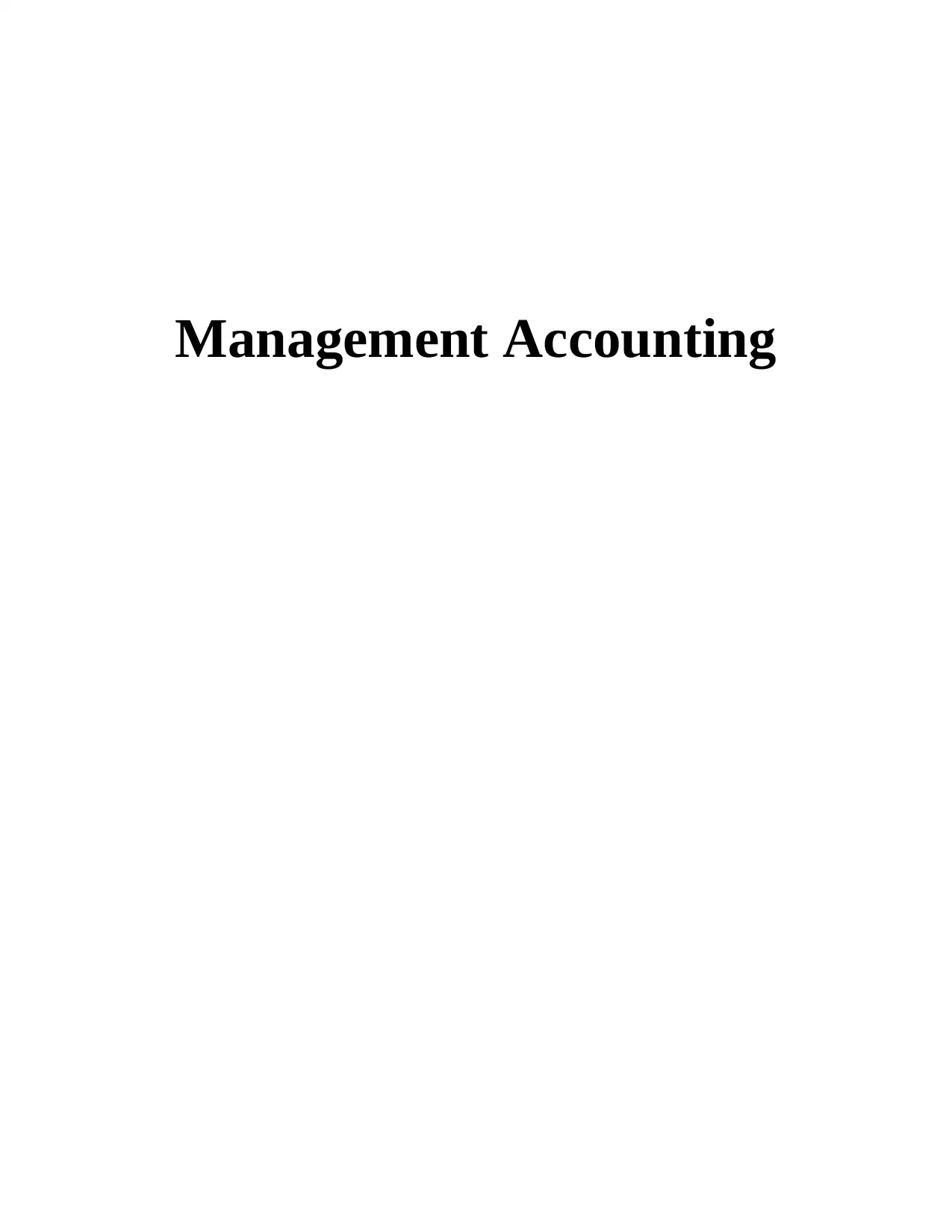
Management Accounting
Paraphrase This Document
Need a fresh take? Get an instant paraphrase of this document with our AI Paraphraser
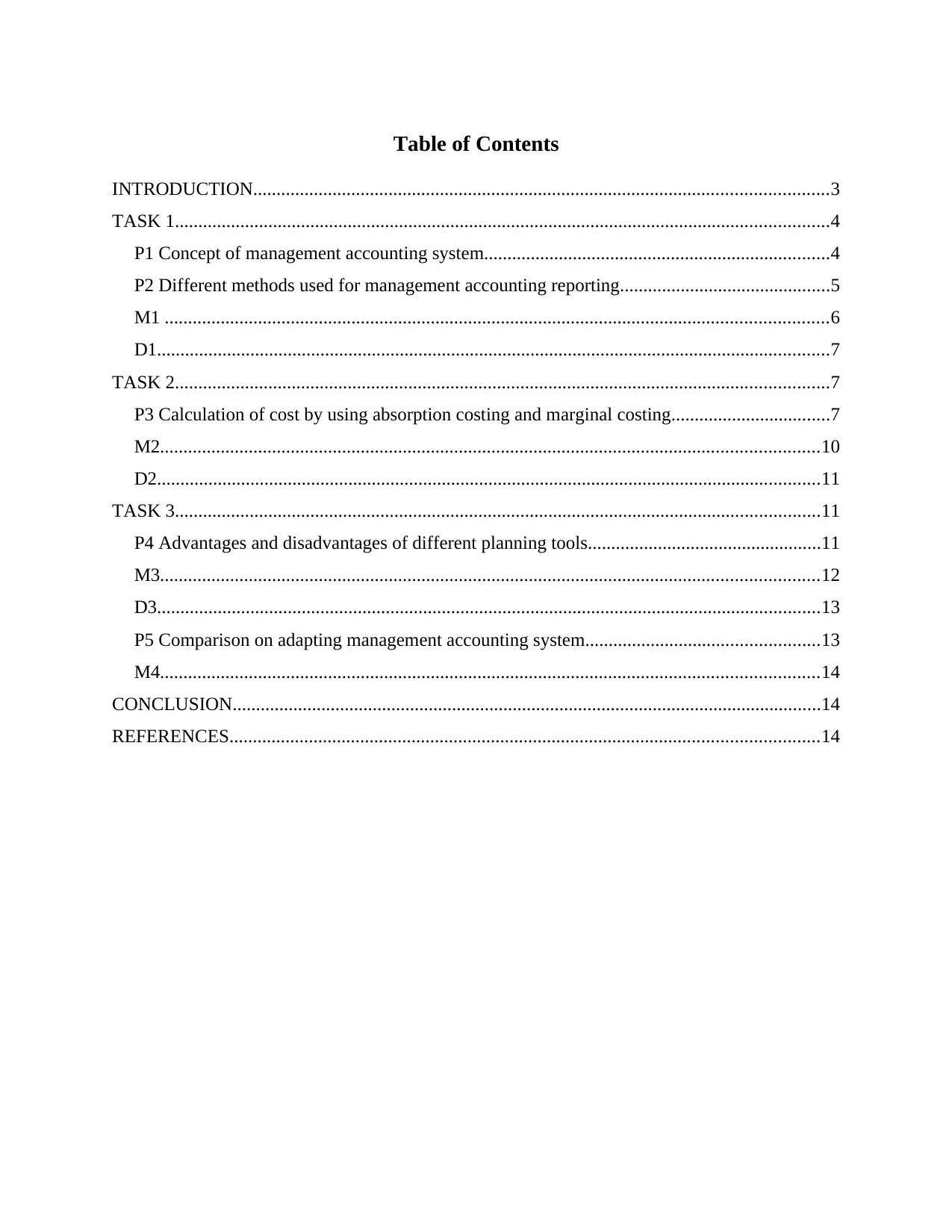
Table of Contents
INTRODUCTION...........................................................................................................................3
TASK 1............................................................................................................................................4
P1 Concept of management accounting system..........................................................................4
P2 Different methods used for management accounting reporting.............................................5
M1 ..............................................................................................................................................6
D1................................................................................................................................................7
TASK 2............................................................................................................................................7
P3 Calculation of cost by using absorption costing and marginal costing..................................7
M2.............................................................................................................................................10
D2..............................................................................................................................................11
TASK 3..........................................................................................................................................11
P4 Advantages and disadvantages of different planning tools..................................................11
M3.............................................................................................................................................12
D3..............................................................................................................................................13
P5 Comparison on adapting management accounting system..................................................13
M4.............................................................................................................................................14
CONCLUSION..............................................................................................................................14
REFERENCES..............................................................................................................................14
INTRODUCTION...........................................................................................................................3
TASK 1............................................................................................................................................4
P1 Concept of management accounting system..........................................................................4
P2 Different methods used for management accounting reporting.............................................5
M1 ..............................................................................................................................................6
D1................................................................................................................................................7
TASK 2............................................................................................................................................7
P3 Calculation of cost by using absorption costing and marginal costing..................................7
M2.............................................................................................................................................10
D2..............................................................................................................................................11
TASK 3..........................................................................................................................................11
P4 Advantages and disadvantages of different planning tools..................................................11
M3.............................................................................................................................................12
D3..............................................................................................................................................13
P5 Comparison on adapting management accounting system..................................................13
M4.............................................................................................................................................14
CONCLUSION..............................................................................................................................14
REFERENCES..............................................................................................................................14
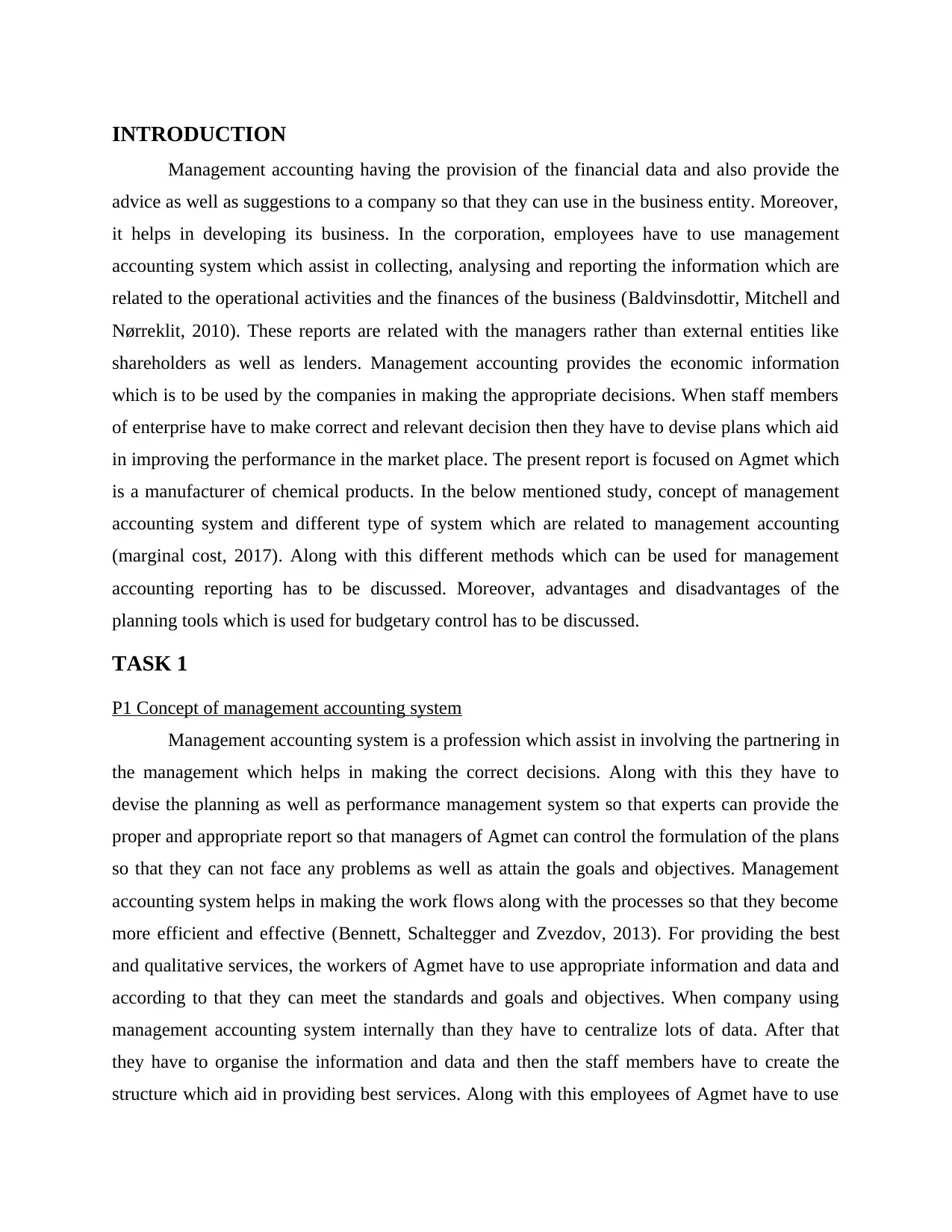
INTRODUCTION
Management accounting having the provision of the financial data and also provide the
advice as well as suggestions to a company so that they can use in the business entity. Moreover,
it helps in developing its business. In the corporation, employees have to use management
accounting system which assist in collecting, analysing and reporting the information which are
related to the operational activities and the finances of the business (Baldvinsdottir, Mitchell and
Nørreklit, 2010). These reports are related with the managers rather than external entities like
shareholders as well as lenders. Management accounting provides the economic information
which is to be used by the companies in making the appropriate decisions. When staff members
of enterprise have to make correct and relevant decision then they have to devise plans which aid
in improving the performance in the market place. The present report is focused on Agmet which
is a manufacturer of chemical products. In the below mentioned study, concept of management
accounting system and different type of system which are related to management accounting
(marginal cost, 2017). Along with this different methods which can be used for management
accounting reporting has to be discussed. Moreover, advantages and disadvantages of the
planning tools which is used for budgetary control has to be discussed.
TASK 1
P1 Concept of management accounting system
Management accounting system is a profession which assist in involving the partnering in
the management which helps in making the correct decisions. Along with this they have to
devise the planning as well as performance management system so that experts can provide the
proper and appropriate report so that managers of Agmet can control the formulation of the plans
so that they can not face any problems as well as attain the goals and objectives. Management
accounting system helps in making the work flows along with the processes so that they become
more efficient and effective (Bennett, Schaltegger and Zvezdov, 2013). For providing the best
and qualitative services, the workers of Agmet have to use appropriate information and data and
according to that they can meet the standards and goals and objectives. When company using
management accounting system internally than they have to centralize lots of data. After that
they have to organise the information and data and then the staff members have to create the
structure which aid in providing best services. Along with this employees of Agmet have to use
Management accounting having the provision of the financial data and also provide the
advice as well as suggestions to a company so that they can use in the business entity. Moreover,
it helps in developing its business. In the corporation, employees have to use management
accounting system which assist in collecting, analysing and reporting the information which are
related to the operational activities and the finances of the business (Baldvinsdottir, Mitchell and
Nørreklit, 2010). These reports are related with the managers rather than external entities like
shareholders as well as lenders. Management accounting provides the economic information
which is to be used by the companies in making the appropriate decisions. When staff members
of enterprise have to make correct and relevant decision then they have to devise plans which aid
in improving the performance in the market place. The present report is focused on Agmet which
is a manufacturer of chemical products. In the below mentioned study, concept of management
accounting system and different type of system which are related to management accounting
(marginal cost, 2017). Along with this different methods which can be used for management
accounting reporting has to be discussed. Moreover, advantages and disadvantages of the
planning tools which is used for budgetary control has to be discussed.
TASK 1
P1 Concept of management accounting system
Management accounting system is a profession which assist in involving the partnering in
the management which helps in making the correct decisions. Along with this they have to
devise the planning as well as performance management system so that experts can provide the
proper and appropriate report so that managers of Agmet can control the formulation of the plans
so that they can not face any problems as well as attain the goals and objectives. Management
accounting system helps in making the work flows along with the processes so that they become
more efficient and effective (Bennett, Schaltegger and Zvezdov, 2013). For providing the best
and qualitative services, the workers of Agmet have to use appropriate information and data and
according to that they can meet the standards and goals and objectives. When company using
management accounting system internally than they have to centralize lots of data. After that
they have to organise the information and data and then the staff members have to create the
structure which aid in providing best services. Along with this employees of Agmet have to use
You're viewing a preview
Unlock full access by subscribing today!
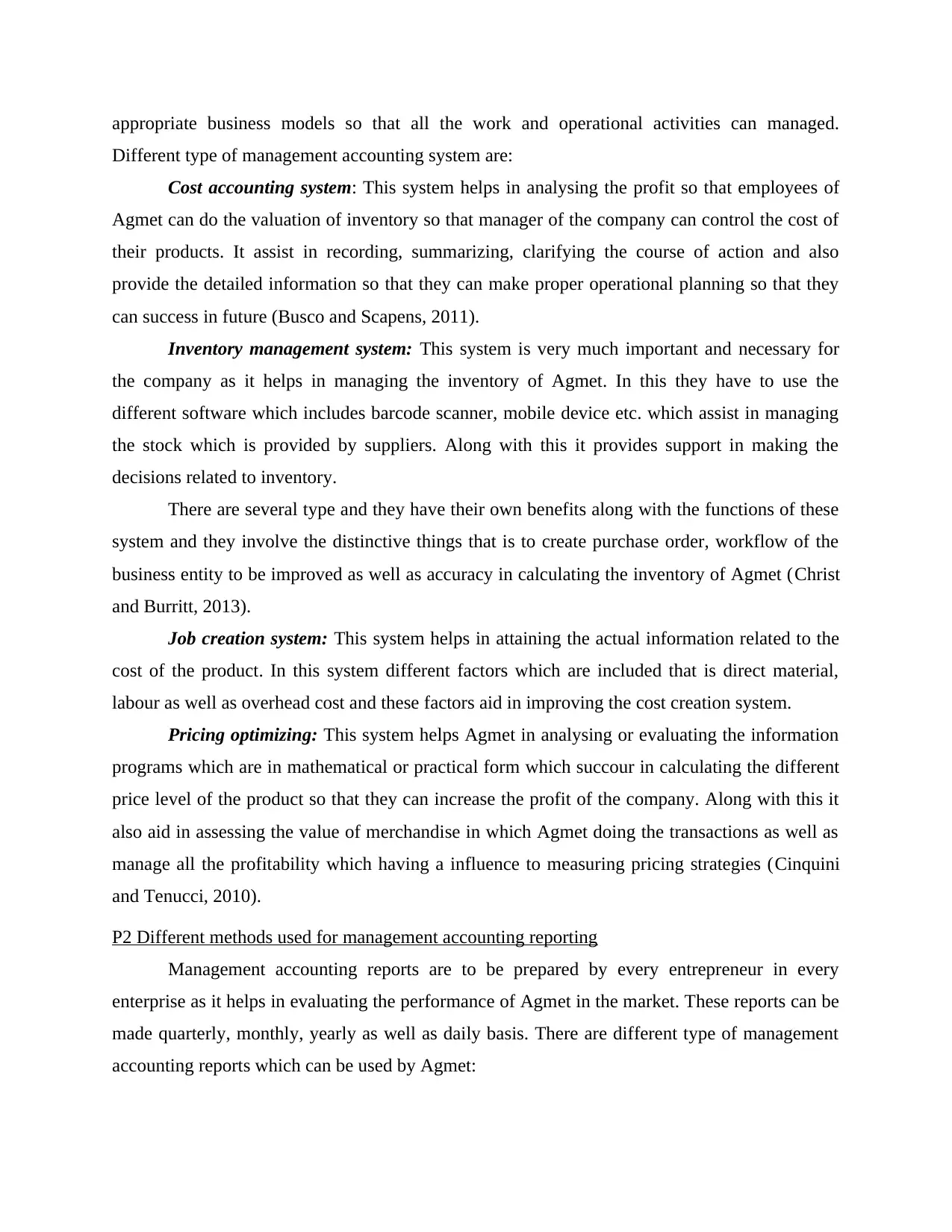
appropriate business models so that all the work and operational activities can managed.
Different type of management accounting system are:
Cost accounting system: This system helps in analysing the profit so that employees of
Agmet can do the valuation of inventory so that manager of the company can control the cost of
their products. It assist in recording, summarizing, clarifying the course of action and also
provide the detailed information so that they can make proper operational planning so that they
can success in future (Busco and Scapens, 2011).
Inventory management system: This system is very much important and necessary for
the company as it helps in managing the inventory of Agmet. In this they have to use the
different software which includes barcode scanner, mobile device etc. which assist in managing
the stock which is provided by suppliers. Along with this it provides support in making the
decisions related to inventory.
There are several type and they have their own benefits along with the functions of these
system and they involve the distinctive things that is to create purchase order, workflow of the
business entity to be improved as well as accuracy in calculating the inventory of Agmet (Christ
and Burritt, 2013).
Job creation system: This system helps in attaining the actual information related to the
cost of the product. In this system different factors which are included that is direct material,
labour as well as overhead cost and these factors aid in improving the cost creation system.
Pricing optimizing: This system helps Agmet in analysing or evaluating the information
programs which are in mathematical or practical form which succour in calculating the different
price level of the product so that they can increase the profit of the company. Along with this it
also aid in assessing the value of merchandise in which Agmet doing the transactions as well as
manage all the profitability which having a influence to measuring pricing strategies (Cinquini
and Tenucci, 2010).
P2 Different methods used for management accounting reporting
Management accounting reports are to be prepared by every entrepreneur in every
enterprise as it helps in evaluating the performance of Agmet in the market. These reports can be
made quarterly, monthly, yearly as well as daily basis. There are different type of management
accounting reports which can be used by Agmet:
Different type of management accounting system are:
Cost accounting system: This system helps in analysing the profit so that employees of
Agmet can do the valuation of inventory so that manager of the company can control the cost of
their products. It assist in recording, summarizing, clarifying the course of action and also
provide the detailed information so that they can make proper operational planning so that they
can success in future (Busco and Scapens, 2011).
Inventory management system: This system is very much important and necessary for
the company as it helps in managing the inventory of Agmet. In this they have to use the
different software which includes barcode scanner, mobile device etc. which assist in managing
the stock which is provided by suppliers. Along with this it provides support in making the
decisions related to inventory.
There are several type and they have their own benefits along with the functions of these
system and they involve the distinctive things that is to create purchase order, workflow of the
business entity to be improved as well as accuracy in calculating the inventory of Agmet (Christ
and Burritt, 2013).
Job creation system: This system helps in attaining the actual information related to the
cost of the product. In this system different factors which are included that is direct material,
labour as well as overhead cost and these factors aid in improving the cost creation system.
Pricing optimizing: This system helps Agmet in analysing or evaluating the information
programs which are in mathematical or practical form which succour in calculating the different
price level of the product so that they can increase the profit of the company. Along with this it
also aid in assessing the value of merchandise in which Agmet doing the transactions as well as
manage all the profitability which having a influence to measuring pricing strategies (Cinquini
and Tenucci, 2010).
P2 Different methods used for management accounting reporting
Management accounting reports are to be prepared by every entrepreneur in every
enterprise as it helps in evaluating the performance of Agmet in the market. These reports can be
made quarterly, monthly, yearly as well as daily basis. There are different type of management
accounting reports which can be used by Agmet:
Paraphrase This Document
Need a fresh take? Get an instant paraphrase of this document with our AI Paraphraser
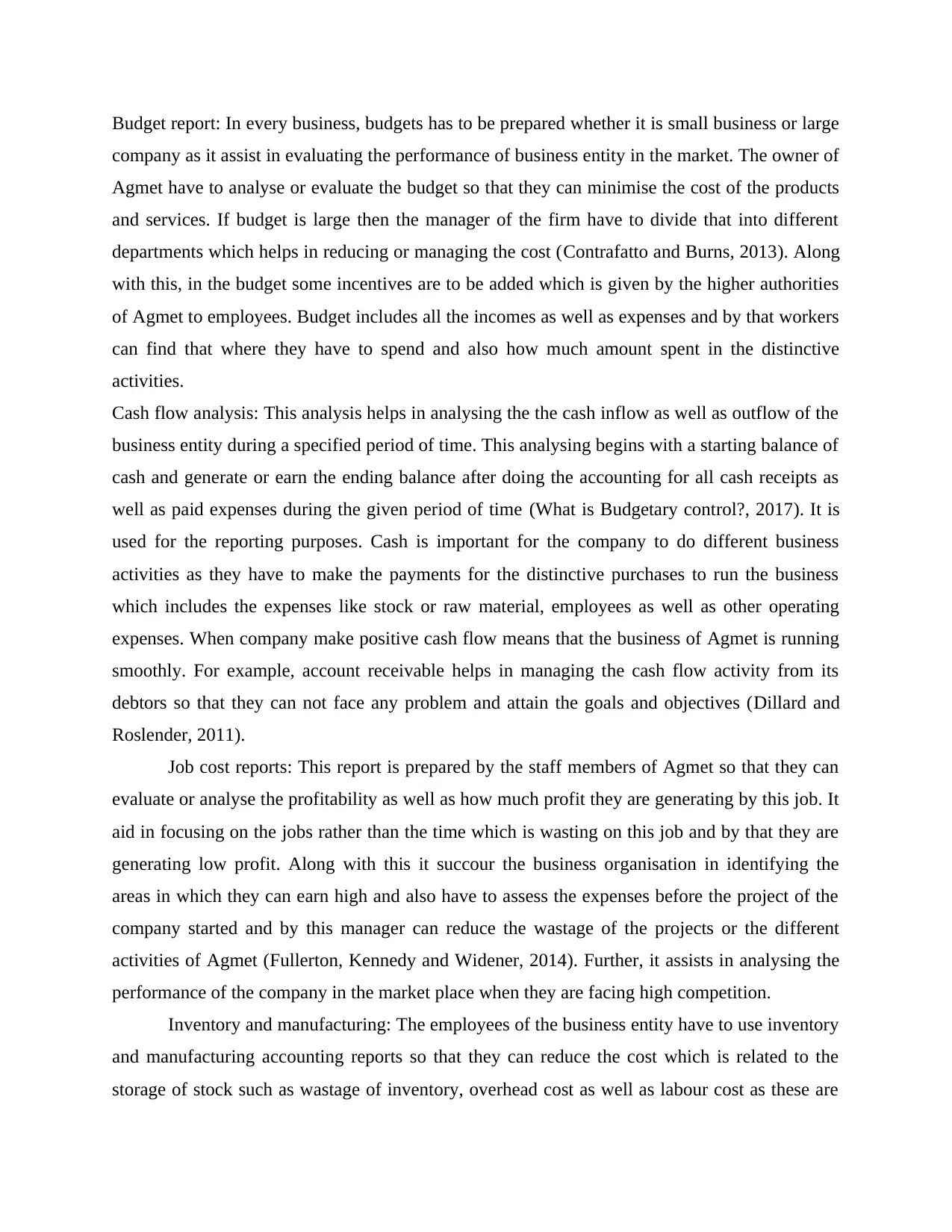
Budget report: In every business, budgets has to be prepared whether it is small business or large
company as it assist in evaluating the performance of business entity in the market. The owner of
Agmet have to analyse or evaluate the budget so that they can minimise the cost of the products
and services. If budget is large then the manager of the firm have to divide that into different
departments which helps in reducing or managing the cost (Contrafatto and Burns, 2013). Along
with this, in the budget some incentives are to be added which is given by the higher authorities
of Agmet to employees. Budget includes all the incomes as well as expenses and by that workers
can find that where they have to spend and also how much amount spent in the distinctive
activities.
Cash flow analysis: This analysis helps in analysing the the cash inflow as well as outflow of the
business entity during a specified period of time. This analysing begins with a starting balance of
cash and generate or earn the ending balance after doing the accounting for all cash receipts as
well as paid expenses during the given period of time (What is Budgetary control?, 2017). It is
used for the reporting purposes. Cash is important for the company to do different business
activities as they have to make the payments for the distinctive purchases to run the business
which includes the expenses like stock or raw material, employees as well as other operating
expenses. When company make positive cash flow means that the business of Agmet is running
smoothly. For example, account receivable helps in managing the cash flow activity from its
debtors so that they can not face any problem and attain the goals and objectives (Dillard and
Roslender, 2011).
Job cost reports: This report is prepared by the staff members of Agmet so that they can
evaluate or analyse the profitability as well as how much profit they are generating by this job. It
aid in focusing on the jobs rather than the time which is wasting on this job and by that they are
generating low profit. Along with this it succour the business organisation in identifying the
areas in which they can earn high and also have to assess the expenses before the project of the
company started and by this manager can reduce the wastage of the projects or the different
activities of Agmet (Fullerton, Kennedy and Widener, 2014). Further, it assists in analysing the
performance of the company in the market place when they are facing high competition.
Inventory and manufacturing: The employees of the business entity have to use inventory
and manufacturing accounting reports so that they can reduce the cost which is related to the
storage of stock such as wastage of inventory, overhead cost as well as labour cost as these are
company as it assist in evaluating the performance of business entity in the market. The owner of
Agmet have to analyse or evaluate the budget so that they can minimise the cost of the products
and services. If budget is large then the manager of the firm have to divide that into different
departments which helps in reducing or managing the cost (Contrafatto and Burns, 2013). Along
with this, in the budget some incentives are to be added which is given by the higher authorities
of Agmet to employees. Budget includes all the incomes as well as expenses and by that workers
can find that where they have to spend and also how much amount spent in the distinctive
activities.
Cash flow analysis: This analysis helps in analysing the the cash inflow as well as outflow of the
business entity during a specified period of time. This analysing begins with a starting balance of
cash and generate or earn the ending balance after doing the accounting for all cash receipts as
well as paid expenses during the given period of time (What is Budgetary control?, 2017). It is
used for the reporting purposes. Cash is important for the company to do different business
activities as they have to make the payments for the distinctive purchases to run the business
which includes the expenses like stock or raw material, employees as well as other operating
expenses. When company make positive cash flow means that the business of Agmet is running
smoothly. For example, account receivable helps in managing the cash flow activity from its
debtors so that they can not face any problem and attain the goals and objectives (Dillard and
Roslender, 2011).
Job cost reports: This report is prepared by the staff members of Agmet so that they can
evaluate or analyse the profitability as well as how much profit they are generating by this job. It
aid in focusing on the jobs rather than the time which is wasting on this job and by that they are
generating low profit. Along with this it succour the business organisation in identifying the
areas in which they can earn high and also have to assess the expenses before the project of the
company started and by this manager can reduce the wastage of the projects or the different
activities of Agmet (Fullerton, Kennedy and Widener, 2014). Further, it assists in analysing the
performance of the company in the market place when they are facing high competition.
Inventory and manufacturing: The employees of the business entity have to use inventory
and manufacturing accounting reports so that they can reduce the cost which is related to the
storage of stock such as wastage of inventory, overhead cost as well as labour cost as these are
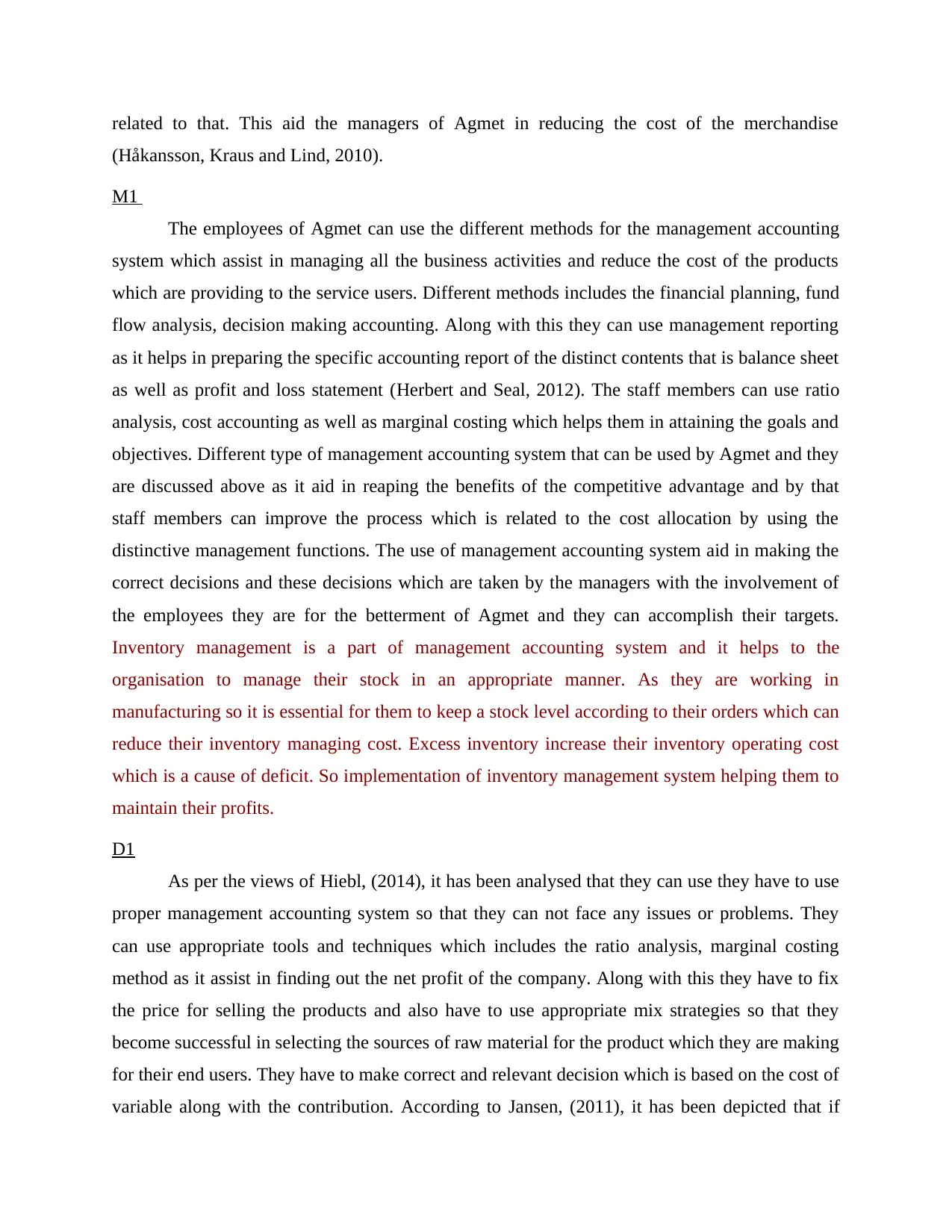
related to that. This aid the managers of Agmet in reducing the cost of the merchandise
(Håkansson, Kraus and Lind, 2010).
M1
The employees of Agmet can use the different methods for the management accounting
system which assist in managing all the business activities and reduce the cost of the products
which are providing to the service users. Different methods includes the financial planning, fund
flow analysis, decision making accounting. Along with this they can use management reporting
as it helps in preparing the specific accounting report of the distinct contents that is balance sheet
as well as profit and loss statement (Herbert and Seal, 2012). The staff members can use ratio
analysis, cost accounting as well as marginal costing which helps them in attaining the goals and
objectives. Different type of management accounting system that can be used by Agmet and they
are discussed above as it aid in reaping the benefits of the competitive advantage and by that
staff members can improve the process which is related to the cost allocation by using the
distinctive management functions. The use of management accounting system aid in making the
correct decisions and these decisions which are taken by the managers with the involvement of
the employees they are for the betterment of Agmet and they can accomplish their targets.
Inventory management is a part of management accounting system and it helps to the
organisation to manage their stock in an appropriate manner. As they are working in
manufacturing so it is essential for them to keep a stock level according to their orders which can
reduce their inventory managing cost. Excess inventory increase their inventory operating cost
which is a cause of deficit. So implementation of inventory management system helping them to
maintain their profits.
D1
As per the views of Hiebl, (2014), it has been analysed that they can use they have to use
proper management accounting system so that they can not face any issues or problems. They
can use appropriate tools and techniques which includes the ratio analysis, marginal costing
method as it assist in finding out the net profit of the company. Along with this they have to fix
the price for selling the products and also have to use appropriate mix strategies so that they
become successful in selecting the sources of raw material for the product which they are making
for their end users. They have to make correct and relevant decision which is based on the cost of
variable along with the contribution. According to Jansen, (2011), it has been depicted that if
(Håkansson, Kraus and Lind, 2010).
M1
The employees of Agmet can use the different methods for the management accounting
system which assist in managing all the business activities and reduce the cost of the products
which are providing to the service users. Different methods includes the financial planning, fund
flow analysis, decision making accounting. Along with this they can use management reporting
as it helps in preparing the specific accounting report of the distinct contents that is balance sheet
as well as profit and loss statement (Herbert and Seal, 2012). The staff members can use ratio
analysis, cost accounting as well as marginal costing which helps them in attaining the goals and
objectives. Different type of management accounting system that can be used by Agmet and they
are discussed above as it aid in reaping the benefits of the competitive advantage and by that
staff members can improve the process which is related to the cost allocation by using the
distinctive management functions. The use of management accounting system aid in making the
correct decisions and these decisions which are taken by the managers with the involvement of
the employees they are for the betterment of Agmet and they can accomplish their targets.
Inventory management is a part of management accounting system and it helps to the
organisation to manage their stock in an appropriate manner. As they are working in
manufacturing so it is essential for them to keep a stock level according to their orders which can
reduce their inventory managing cost. Excess inventory increase their inventory operating cost
which is a cause of deficit. So implementation of inventory management system helping them to
maintain their profits.
D1
As per the views of Hiebl, (2014), it has been analysed that they can use they have to use
proper management accounting system so that they can not face any issues or problems. They
can use appropriate tools and techniques which includes the ratio analysis, marginal costing
method as it assist in finding out the net profit of the company. Along with this they have to fix
the price for selling the products and also have to use appropriate mix strategies so that they
become successful in selecting the sources of raw material for the product which they are making
for their end users. They have to make correct and relevant decision which is based on the cost of
variable along with the contribution. According to Jansen, (2011), it has been depicted that if
You're viewing a preview
Unlock full access by subscribing today!
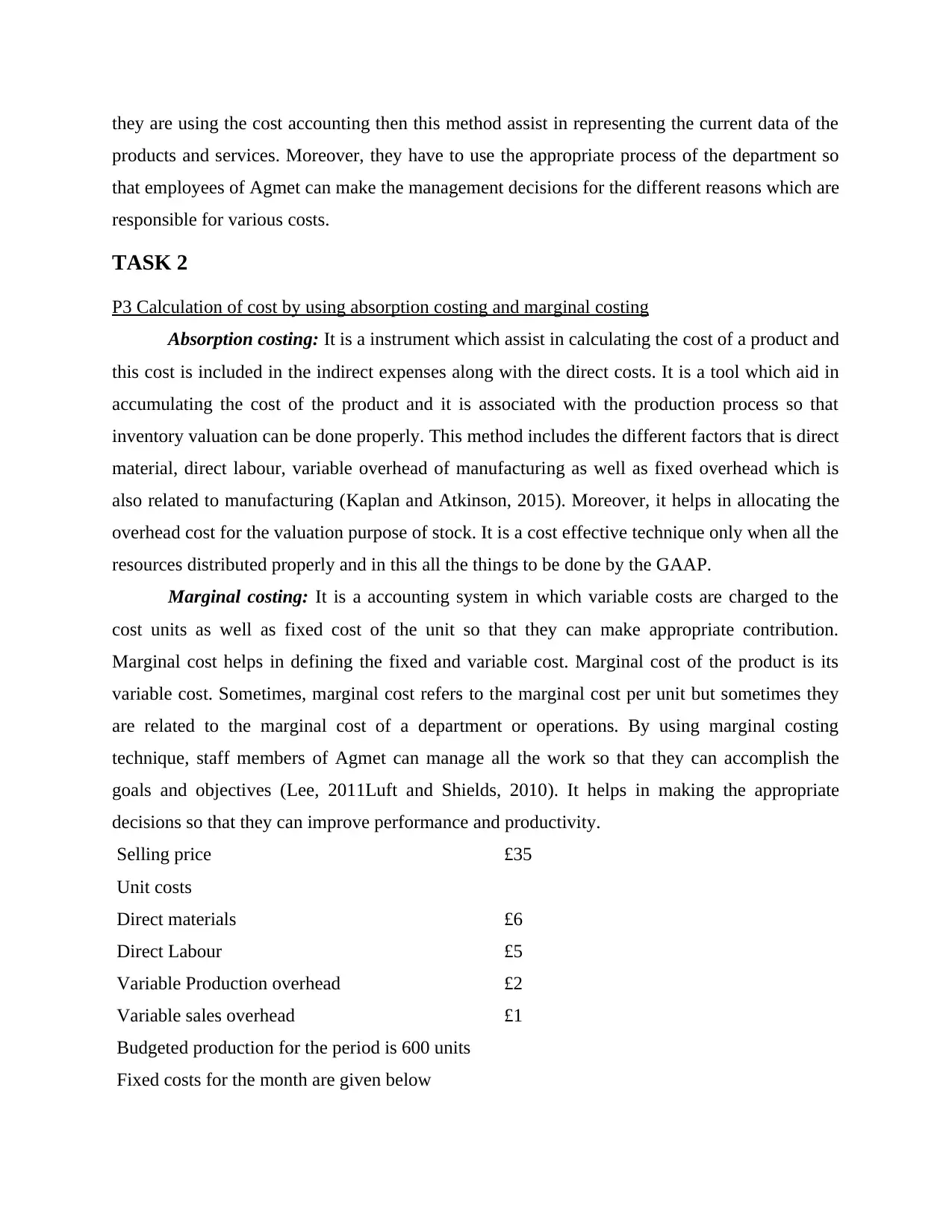
they are using the cost accounting then this method assist in representing the current data of the
products and services. Moreover, they have to use the appropriate process of the department so
that employees of Agmet can make the management decisions for the different reasons which are
responsible for various costs.
TASK 2
P3 Calculation of cost by using absorption costing and marginal costing
Absorption costing: It is a instrument which assist in calculating the cost of a product and
this cost is included in the indirect expenses along with the direct costs. It is a tool which aid in
accumulating the cost of the product and it is associated with the production process so that
inventory valuation can be done properly. This method includes the different factors that is direct
material, direct labour, variable overhead of manufacturing as well as fixed overhead which is
also related to manufacturing (Kaplan and Atkinson, 2015). Moreover, it helps in allocating the
overhead cost for the valuation purpose of stock. It is a cost effective technique only when all the
resources distributed properly and in this all the things to be done by the GAAP.
Marginal costing: It is a accounting system in which variable costs are charged to the
cost units as well as fixed cost of the unit so that they can make appropriate contribution.
Marginal cost helps in defining the fixed and variable cost. Marginal cost of the product is its
variable cost. Sometimes, marginal cost refers to the marginal cost per unit but sometimes they
are related to the marginal cost of a department or operations. By using marginal costing
technique, staff members of Agmet can manage all the work so that they can accomplish the
goals and objectives (Lee, 2011Luft and Shields, 2010). It helps in making the appropriate
decisions so that they can improve performance and productivity.
Selling price £35
Unit costs
Direct materials £6
Direct Labour £5
Variable Production overhead £2
Variable sales overhead £1
Budgeted production for the period is 600 units
Fixed costs for the month are given below
products and services. Moreover, they have to use the appropriate process of the department so
that employees of Agmet can make the management decisions for the different reasons which are
responsible for various costs.
TASK 2
P3 Calculation of cost by using absorption costing and marginal costing
Absorption costing: It is a instrument which assist in calculating the cost of a product and
this cost is included in the indirect expenses along with the direct costs. It is a tool which aid in
accumulating the cost of the product and it is associated with the production process so that
inventory valuation can be done properly. This method includes the different factors that is direct
material, direct labour, variable overhead of manufacturing as well as fixed overhead which is
also related to manufacturing (Kaplan and Atkinson, 2015). Moreover, it helps in allocating the
overhead cost for the valuation purpose of stock. It is a cost effective technique only when all the
resources distributed properly and in this all the things to be done by the GAAP.
Marginal costing: It is a accounting system in which variable costs are charged to the
cost units as well as fixed cost of the unit so that they can make appropriate contribution.
Marginal cost helps in defining the fixed and variable cost. Marginal cost of the product is its
variable cost. Sometimes, marginal cost refers to the marginal cost per unit but sometimes they
are related to the marginal cost of a department or operations. By using marginal costing
technique, staff members of Agmet can manage all the work so that they can accomplish the
goals and objectives (Lee, 2011Luft and Shields, 2010). It helps in making the appropriate
decisions so that they can improve performance and productivity.
Selling price £35
Unit costs
Direct materials £6
Direct Labour £5
Variable Production overhead £2
Variable sales overhead £1
Budgeted production for the period is 600 units
Fixed costs for the month are given below
Paraphrase This Document
Need a fresh take? Get an instant paraphrase of this document with our AI Paraphraser
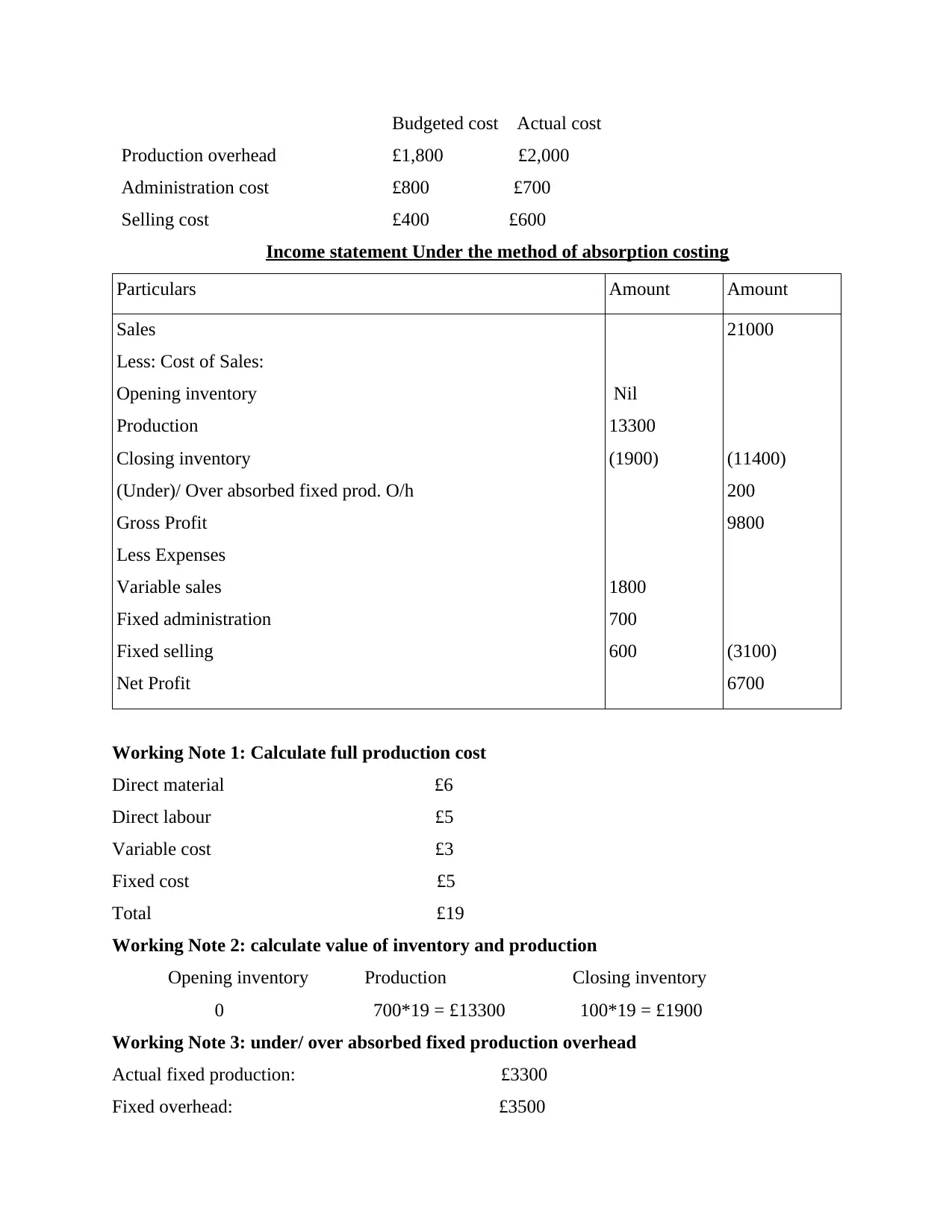
Budgeted cost Actual cost
Production overhead £1,800 £2,000
Administration cost £800 £700
Selling cost £400 £600
Income statement Under the method of absorption costing
Particulars Amount Amount
Sales
Less: Cost of Sales:
Opening inventory
Production
Closing inventory
(Under)/ Over absorbed fixed prod. O/h
Gross Profit
Less Expenses
Variable sales
Fixed administration
Fixed selling
Net Profit
Nil
13300
(1900)
1800
700
600
21000
(11400)
200
9800
(3100)
6700
Working Note 1: Calculate full production cost
Direct material £6
Direct labour £5
Variable cost £3
Fixed cost £5
Total £19
Working Note 2: calculate value of inventory and production
Opening inventory Production Closing inventory
0 700*19 = £13300 100*19 = £1900
Working Note 3: under/ over absorbed fixed production overhead
Actual fixed production: £3300
Fixed overhead: £3500
Production overhead £1,800 £2,000
Administration cost £800 £700
Selling cost £400 £600
Income statement Under the method of absorption costing
Particulars Amount Amount
Sales
Less: Cost of Sales:
Opening inventory
Production
Closing inventory
(Under)/ Over absorbed fixed prod. O/h
Gross Profit
Less Expenses
Variable sales
Fixed administration
Fixed selling
Net Profit
Nil
13300
(1900)
1800
700
600
21000
(11400)
200
9800
(3100)
6700
Working Note 1: Calculate full production cost
Direct material £6
Direct labour £5
Variable cost £3
Fixed cost £5
Total £19
Working Note 2: calculate value of inventory and production
Opening inventory Production Closing inventory
0 700*19 = £13300 100*19 = £1900
Working Note 3: under/ over absorbed fixed production overhead
Actual fixed production: £3300
Fixed overhead: £3500
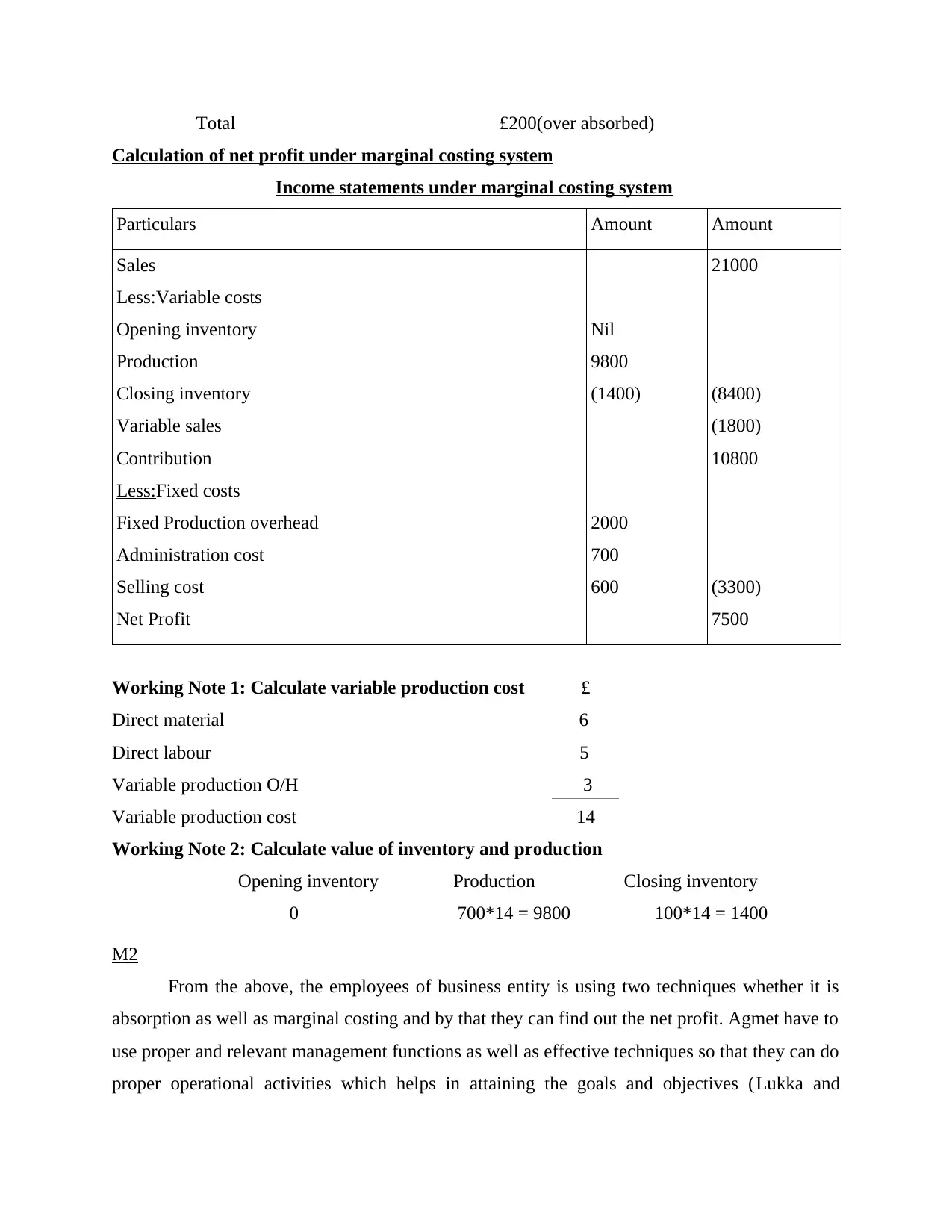
Total £200(over absorbed)
Calculation of net profit under marginal costing system
Income statements under marginal costing system
Particulars Amount Amount
Sales
Less:Variable costs
Opening inventory
Production
Closing inventory
Variable sales
Contribution
Less:Fixed costs
Fixed Production overhead
Administration cost
Selling cost
Net Profit
Nil
9800
(1400)
2000
700
600
21000
(8400)
(1800)
10800
(3300)
7500
Working Note 1: Calculate variable production cost £
Direct material 6
Direct labour 5
Variable production O/H 3
Variable production cost 14
Working Note 2: Calculate value of inventory and production
Opening inventory Production Closing inventory
0 700*14 = 9800 100*14 = 1400
M2
From the above, the employees of business entity is using two techniques whether it is
absorption as well as marginal costing and by that they can find out the net profit. Agmet have to
use proper and relevant management functions as well as effective techniques so that they can do
proper operational activities which helps in attaining the goals and objectives (Lukka and
Calculation of net profit under marginal costing system
Income statements under marginal costing system
Particulars Amount Amount
Sales
Less:Variable costs
Opening inventory
Production
Closing inventory
Variable sales
Contribution
Less:Fixed costs
Fixed Production overhead
Administration cost
Selling cost
Net Profit
Nil
9800
(1400)
2000
700
600
21000
(8400)
(1800)
10800
(3300)
7500
Working Note 1: Calculate variable production cost £
Direct material 6
Direct labour 5
Variable production O/H 3
Variable production cost 14
Working Note 2: Calculate value of inventory and production
Opening inventory Production Closing inventory
0 700*14 = 9800 100*14 = 1400
M2
From the above, the employees of business entity is using two techniques whether it is
absorption as well as marginal costing and by that they can find out the net profit. Agmet have to
use proper and relevant management functions as well as effective techniques so that they can do
proper operational activities which helps in attaining the goals and objectives (Lukka and
You're viewing a preview
Unlock full access by subscribing today!
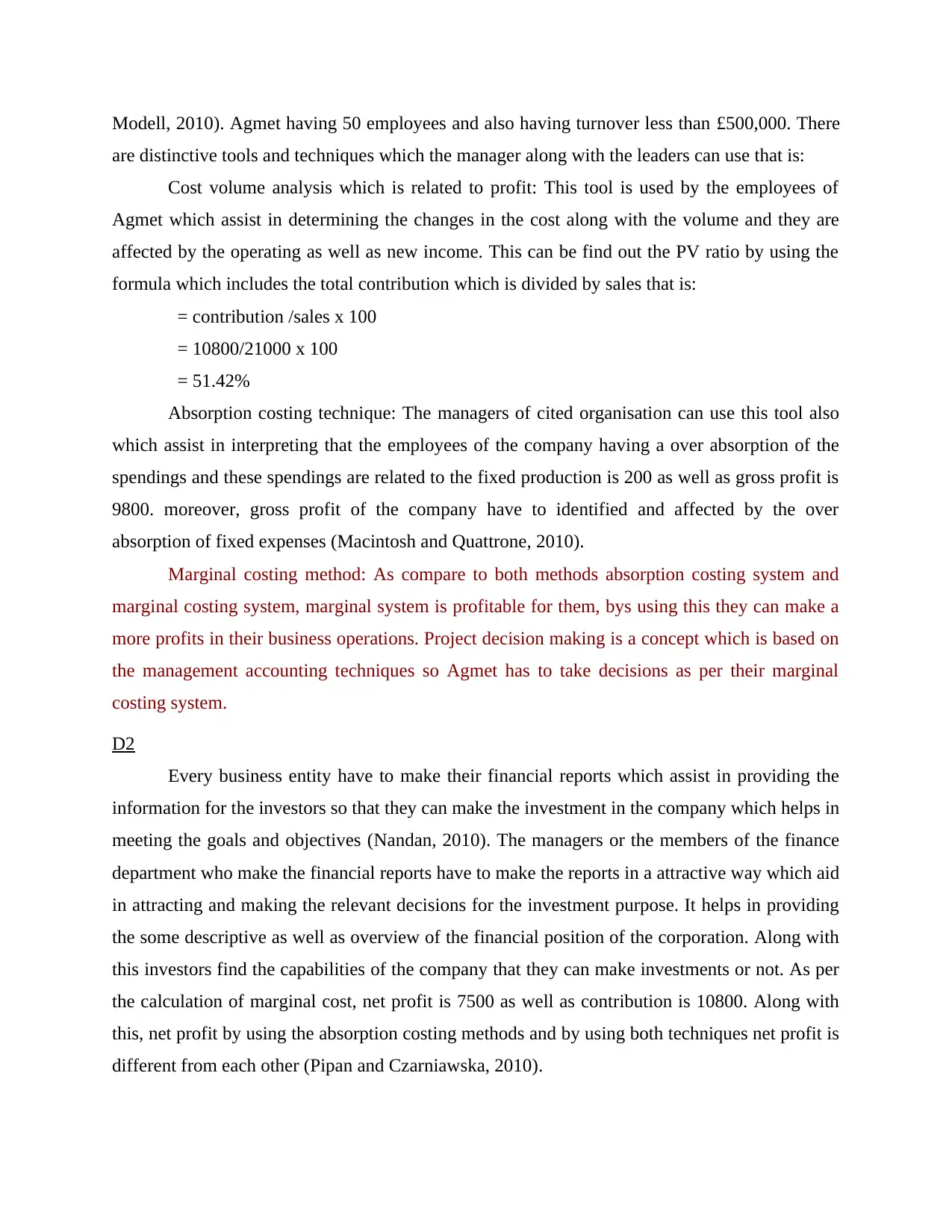
Modell, 2010). Agmet having 50 employees and also having turnover less than £500,000. There
are distinctive tools and techniques which the manager along with the leaders can use that is:
Cost volume analysis which is related to profit: This tool is used by the employees of
Agmet which assist in determining the changes in the cost along with the volume and they are
affected by the operating as well as new income. This can be find out the PV ratio by using the
formula which includes the total contribution which is divided by sales that is:
= contribution /sales x 100
= 10800/21000 x 100
= 51.42%
Absorption costing technique: The managers of cited organisation can use this tool also
which assist in interpreting that the employees of the company having a over absorption of the
spendings and these spendings are related to the fixed production is 200 as well as gross profit is
9800. moreover, gross profit of the company have to identified and affected by the over
absorption of fixed expenses (Macintosh and Quattrone, 2010).
Marginal costing method: As compare to both methods absorption costing system and
marginal costing system, marginal system is profitable for them, bys using this they can make a
more profits in their business operations. Project decision making is a concept which is based on
the management accounting techniques so Agmet has to take decisions as per their marginal
costing system.
D2
Every business entity have to make their financial reports which assist in providing the
information for the investors so that they can make the investment in the company which helps in
meeting the goals and objectives (Nandan, 2010). The managers or the members of the finance
department who make the financial reports have to make the reports in a attractive way which aid
in attracting and making the relevant decisions for the investment purpose. It helps in providing
the some descriptive as well as overview of the financial position of the corporation. Along with
this investors find the capabilities of the company that they can make investments or not. As per
the calculation of marginal cost, net profit is 7500 as well as contribution is 10800. Along with
this, net profit by using the absorption costing methods and by using both techniques net profit is
different from each other (Pipan and Czarniawska, 2010).
are distinctive tools and techniques which the manager along with the leaders can use that is:
Cost volume analysis which is related to profit: This tool is used by the employees of
Agmet which assist in determining the changes in the cost along with the volume and they are
affected by the operating as well as new income. This can be find out the PV ratio by using the
formula which includes the total contribution which is divided by sales that is:
= contribution /sales x 100
= 10800/21000 x 100
= 51.42%
Absorption costing technique: The managers of cited organisation can use this tool also
which assist in interpreting that the employees of the company having a over absorption of the
spendings and these spendings are related to the fixed production is 200 as well as gross profit is
9800. moreover, gross profit of the company have to identified and affected by the over
absorption of fixed expenses (Macintosh and Quattrone, 2010).
Marginal costing method: As compare to both methods absorption costing system and
marginal costing system, marginal system is profitable for them, bys using this they can make a
more profits in their business operations. Project decision making is a concept which is based on
the management accounting techniques so Agmet has to take decisions as per their marginal
costing system.
D2
Every business entity have to make their financial reports which assist in providing the
information for the investors so that they can make the investment in the company which helps in
meeting the goals and objectives (Nandan, 2010). The managers or the members of the finance
department who make the financial reports have to make the reports in a attractive way which aid
in attracting and making the relevant decisions for the investment purpose. It helps in providing
the some descriptive as well as overview of the financial position of the corporation. Along with
this investors find the capabilities of the company that they can make investments or not. As per
the calculation of marginal cost, net profit is 7500 as well as contribution is 10800. Along with
this, net profit by using the absorption costing methods and by using both techniques net profit is
different from each other (Pipan and Czarniawska, 2010).
Paraphrase This Document
Need a fresh take? Get an instant paraphrase of this document with our AI Paraphraser
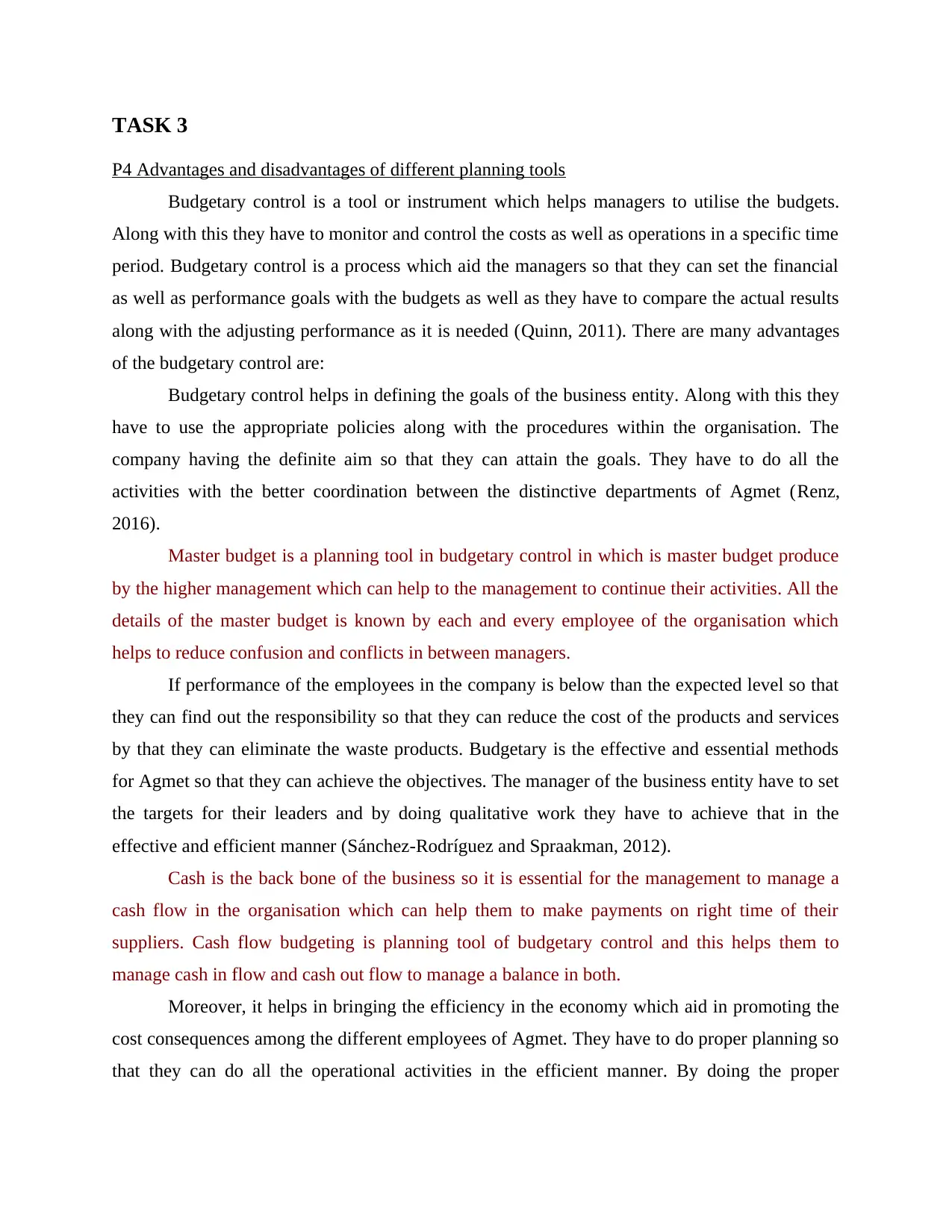
TASK 3
P4 Advantages and disadvantages of different planning tools
Budgetary control is a tool or instrument which helps managers to utilise the budgets.
Along with this they have to monitor and control the costs as well as operations in a specific time
period. Budgetary control is a process which aid the managers so that they can set the financial
as well as performance goals with the budgets as well as they have to compare the actual results
along with the adjusting performance as it is needed (Quinn, 2011). There are many advantages
of the budgetary control are:
Budgetary control helps in defining the goals of the business entity. Along with this they
have to use the appropriate policies along with the procedures within the organisation. The
company having the definite aim so that they can attain the goals. They have to do all the
activities with the better coordination between the distinctive departments of Agmet (Renz,
2016).
Master budget is a planning tool in budgetary control in which is master budget produce
by the higher management which can help to the management to continue their activities. All the
details of the master budget is known by each and every employee of the organisation which
helps to reduce confusion and conflicts in between managers.
If performance of the employees in the company is below than the expected level so that
they can find out the responsibility so that they can reduce the cost of the products and services
by that they can eliminate the waste products. Budgetary is the effective and essential methods
for Agmet so that they can achieve the objectives. The manager of the business entity have to set
the targets for their leaders and by doing qualitative work they have to achieve that in the
effective and efficient manner (Sánchez-Rodríguez and Spraakman, 2012).
Cash is the back bone of the business so it is essential for the management to manage a
cash flow in the organisation which can help them to make payments on right time of their
suppliers. Cash flow budgeting is planning tool of budgetary control and this helps them to
manage cash in flow and cash out flow to manage a balance in both.
Moreover, it helps in bringing the efficiency in the economy which aid in promoting the
cost consequences among the different employees of Agmet. They have to do proper planning so
that they can do all the operational activities in the efficient manner. By doing the proper
P4 Advantages and disadvantages of different planning tools
Budgetary control is a tool or instrument which helps managers to utilise the budgets.
Along with this they have to monitor and control the costs as well as operations in a specific time
period. Budgetary control is a process which aid the managers so that they can set the financial
as well as performance goals with the budgets as well as they have to compare the actual results
along with the adjusting performance as it is needed (Quinn, 2011). There are many advantages
of the budgetary control are:
Budgetary control helps in defining the goals of the business entity. Along with this they
have to use the appropriate policies along with the procedures within the organisation. The
company having the definite aim so that they can attain the goals. They have to do all the
activities with the better coordination between the distinctive departments of Agmet (Renz,
2016).
Master budget is a planning tool in budgetary control in which is master budget produce
by the higher management which can help to the management to continue their activities. All the
details of the master budget is known by each and every employee of the organisation which
helps to reduce confusion and conflicts in between managers.
If performance of the employees in the company is below than the expected level so that
they can find out the responsibility so that they can reduce the cost of the products and services
by that they can eliminate the waste products. Budgetary is the effective and essential methods
for Agmet so that they can achieve the objectives. The manager of the business entity have to set
the targets for their leaders and by doing qualitative work they have to achieve that in the
effective and efficient manner (Sánchez-Rodríguez and Spraakman, 2012).
Cash is the back bone of the business so it is essential for the management to manage a
cash flow in the organisation which can help them to make payments on right time of their
suppliers. Cash flow budgeting is planning tool of budgetary control and this helps them to
manage cash in flow and cash out flow to manage a balance in both.
Moreover, it helps in bringing the efficiency in the economy which aid in promoting the
cost consequences among the different employees of Agmet. They have to do proper planning so
that they can do all the operational activities in the efficient manner. By doing the proper
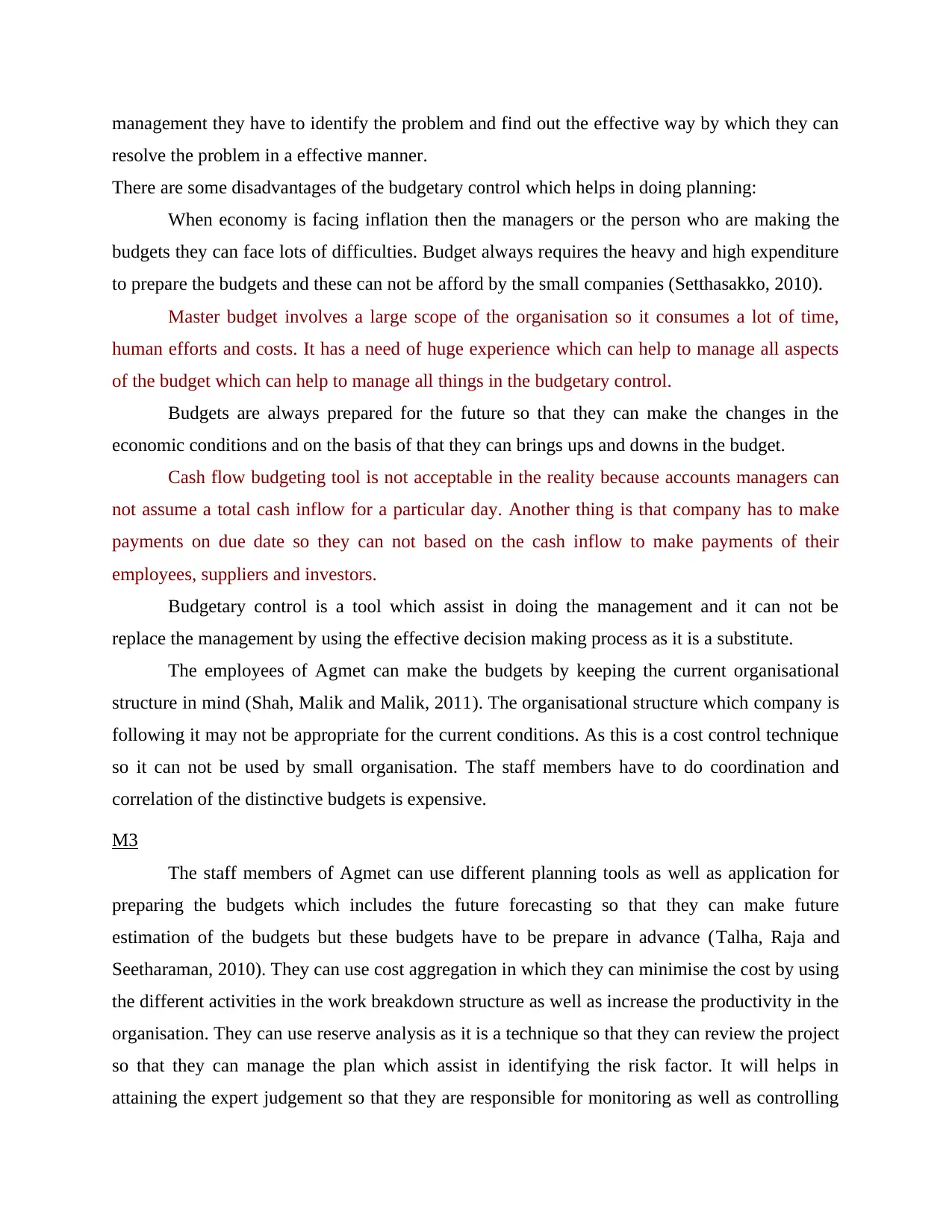
management they have to identify the problem and find out the effective way by which they can
resolve the problem in a effective manner.
There are some disadvantages of the budgetary control which helps in doing planning:
When economy is facing inflation then the managers or the person who are making the
budgets they can face lots of difficulties. Budget always requires the heavy and high expenditure
to prepare the budgets and these can not be afford by the small companies (Setthasakko, 2010).
Master budget involves a large scope of the organisation so it consumes a lot of time,
human efforts and costs. It has a need of huge experience which can help to manage all aspects
of the budget which can help to manage all things in the budgetary control.
Budgets are always prepared for the future so that they can make the changes in the
economic conditions and on the basis of that they can brings ups and downs in the budget.
Cash flow budgeting tool is not acceptable in the reality because accounts managers can
not assume a total cash inflow for a particular day. Another thing is that company has to make
payments on due date so they can not based on the cash inflow to make payments of their
employees, suppliers and investors.
Budgetary control is a tool which assist in doing the management and it can not be
replace the management by using the effective decision making process as it is a substitute.
The employees of Agmet can make the budgets by keeping the current organisational
structure in mind (Shah, Malik and Malik, 2011). The organisational structure which company is
following it may not be appropriate for the current conditions. As this is a cost control technique
so it can not be used by small organisation. The staff members have to do coordination and
correlation of the distinctive budgets is expensive.
M3
The staff members of Agmet can use different planning tools as well as application for
preparing the budgets which includes the future forecasting so that they can make future
estimation of the budgets but these budgets have to be prepare in advance (Talha, Raja and
Seetharaman, 2010). They can use cost aggregation in which they can minimise the cost by using
the different activities in the work breakdown structure as well as increase the productivity in the
organisation. They can use reserve analysis as it is a technique so that they can review the project
so that they can manage the plan which assist in identifying the risk factor. It will helps in
attaining the expert judgement so that they are responsible for monitoring as well as controlling
resolve the problem in a effective manner.
There are some disadvantages of the budgetary control which helps in doing planning:
When economy is facing inflation then the managers or the person who are making the
budgets they can face lots of difficulties. Budget always requires the heavy and high expenditure
to prepare the budgets and these can not be afford by the small companies (Setthasakko, 2010).
Master budget involves a large scope of the organisation so it consumes a lot of time,
human efforts and costs. It has a need of huge experience which can help to manage all aspects
of the budget which can help to manage all things in the budgetary control.
Budgets are always prepared for the future so that they can make the changes in the
economic conditions and on the basis of that they can brings ups and downs in the budget.
Cash flow budgeting tool is not acceptable in the reality because accounts managers can
not assume a total cash inflow for a particular day. Another thing is that company has to make
payments on due date so they can not based on the cash inflow to make payments of their
employees, suppliers and investors.
Budgetary control is a tool which assist in doing the management and it can not be
replace the management by using the effective decision making process as it is a substitute.
The employees of Agmet can make the budgets by keeping the current organisational
structure in mind (Shah, Malik and Malik, 2011). The organisational structure which company is
following it may not be appropriate for the current conditions. As this is a cost control technique
so it can not be used by small organisation. The staff members have to do coordination and
correlation of the distinctive budgets is expensive.
M3
The staff members of Agmet can use different planning tools as well as application for
preparing the budgets which includes the future forecasting so that they can make future
estimation of the budgets but these budgets have to be prepare in advance (Talha, Raja and
Seetharaman, 2010). They can use cost aggregation in which they can minimise the cost by using
the different activities in the work breakdown structure as well as increase the productivity in the
organisation. They can use reserve analysis as it is a technique so that they can review the project
so that they can manage the plan which assist in identifying the risk factor. It will helps in
attaining the expert judgement so that they are responsible for monitoring as well as controlling
You're viewing a preview
Unlock full access by subscribing today!
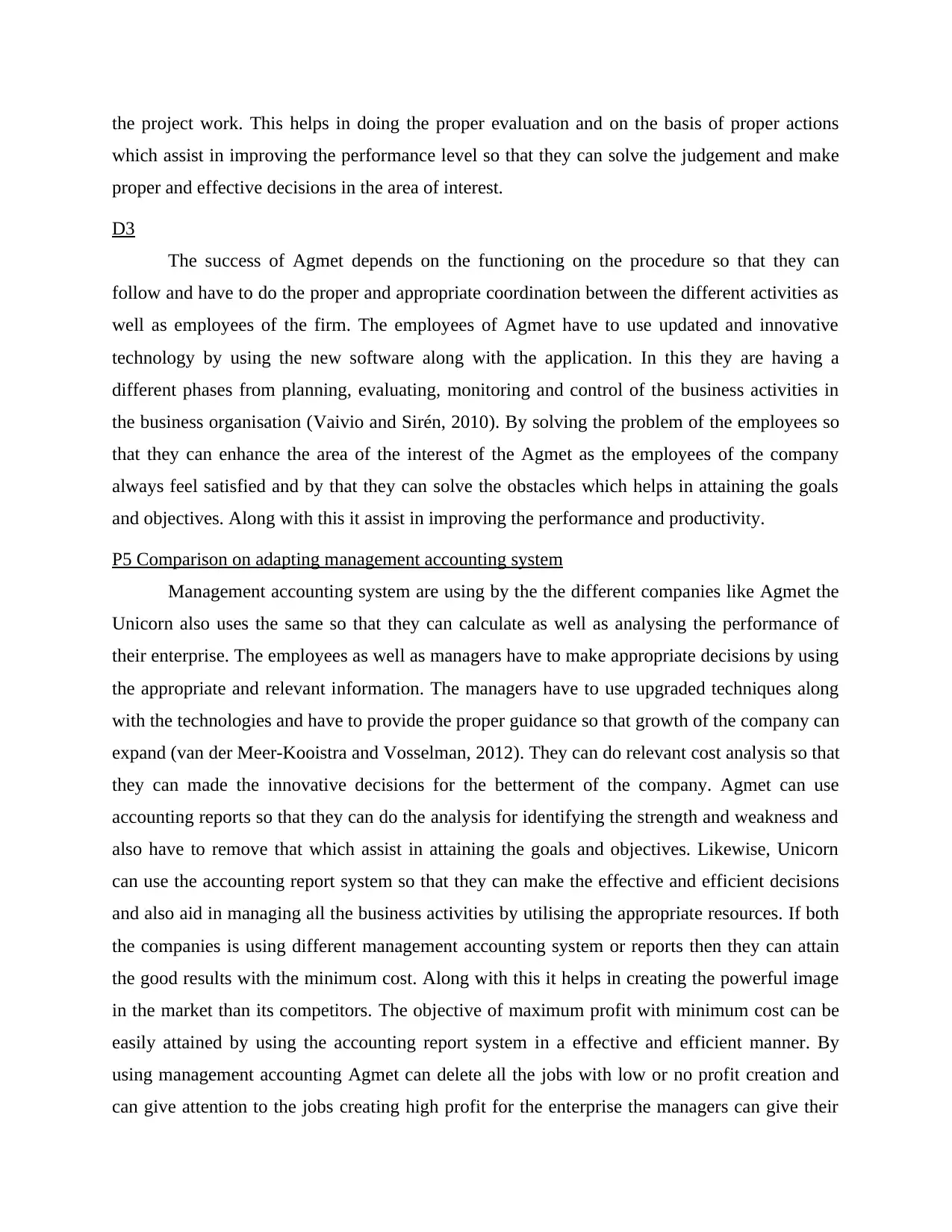
the project work. This helps in doing the proper evaluation and on the basis of proper actions
which assist in improving the performance level so that they can solve the judgement and make
proper and effective decisions in the area of interest.
D3
The success of Agmet depends on the functioning on the procedure so that they can
follow and have to do the proper and appropriate coordination between the different activities as
well as employees of the firm. The employees of Agmet have to use updated and innovative
technology by using the new software along with the application. In this they are having a
different phases from planning, evaluating, monitoring and control of the business activities in
the business organisation (Vaivio and Sirén, 2010). By solving the problem of the employees so
that they can enhance the area of the interest of the Agmet as the employees of the company
always feel satisfied and by that they can solve the obstacles which helps in attaining the goals
and objectives. Along with this it assist in improving the performance and productivity.
P5 Comparison on adapting management accounting system
Management accounting system are using by the the different companies like Agmet the
Unicorn also uses the same so that they can calculate as well as analysing the performance of
their enterprise. The employees as well as managers have to make appropriate decisions by using
the appropriate and relevant information. The managers have to use upgraded techniques along
with the technologies and have to provide the proper guidance so that growth of the company can
expand (van der Meer-Kooistra and Vosselman, 2012). They can do relevant cost analysis so that
they can made the innovative decisions for the betterment of the company. Agmet can use
accounting reports so that they can do the analysis for identifying the strength and weakness and
also have to remove that which assist in attaining the goals and objectives. Likewise, Unicorn
can use the accounting report system so that they can make the effective and efficient decisions
and also aid in managing all the business activities by utilising the appropriate resources. If both
the companies is using different management accounting system or reports then they can attain
the good results with the minimum cost. Along with this it helps in creating the powerful image
in the market than its competitors. The objective of maximum profit with minimum cost can be
easily attained by using the accounting report system in a effective and efficient manner. By
using management accounting Agmet can delete all the jobs with low or no profit creation and
can give attention to the jobs creating high profit for the enterprise the managers can give their
which assist in improving the performance level so that they can solve the judgement and make
proper and effective decisions in the area of interest.
D3
The success of Agmet depends on the functioning on the procedure so that they can
follow and have to do the proper and appropriate coordination between the different activities as
well as employees of the firm. The employees of Agmet have to use updated and innovative
technology by using the new software along with the application. In this they are having a
different phases from planning, evaluating, monitoring and control of the business activities in
the business organisation (Vaivio and Sirén, 2010). By solving the problem of the employees so
that they can enhance the area of the interest of the Agmet as the employees of the company
always feel satisfied and by that they can solve the obstacles which helps in attaining the goals
and objectives. Along with this it assist in improving the performance and productivity.
P5 Comparison on adapting management accounting system
Management accounting system are using by the the different companies like Agmet the
Unicorn also uses the same so that they can calculate as well as analysing the performance of
their enterprise. The employees as well as managers have to make appropriate decisions by using
the appropriate and relevant information. The managers have to use upgraded techniques along
with the technologies and have to provide the proper guidance so that growth of the company can
expand (van der Meer-Kooistra and Vosselman, 2012). They can do relevant cost analysis so that
they can made the innovative decisions for the betterment of the company. Agmet can use
accounting reports so that they can do the analysis for identifying the strength and weakness and
also have to remove that which assist in attaining the goals and objectives. Likewise, Unicorn
can use the accounting report system so that they can make the effective and efficient decisions
and also aid in managing all the business activities by utilising the appropriate resources. If both
the companies is using different management accounting system or reports then they can attain
the good results with the minimum cost. Along with this it helps in creating the powerful image
in the market than its competitors. The objective of maximum profit with minimum cost can be
easily attained by using the accounting report system in a effective and efficient manner. By
using management accounting Agmet can delete all the jobs with low or no profit creation and
can give attention to the jobs creating high profit for the enterprise the managers can give their
Paraphrase This Document
Need a fresh take? Get an instant paraphrase of this document with our AI Paraphraser
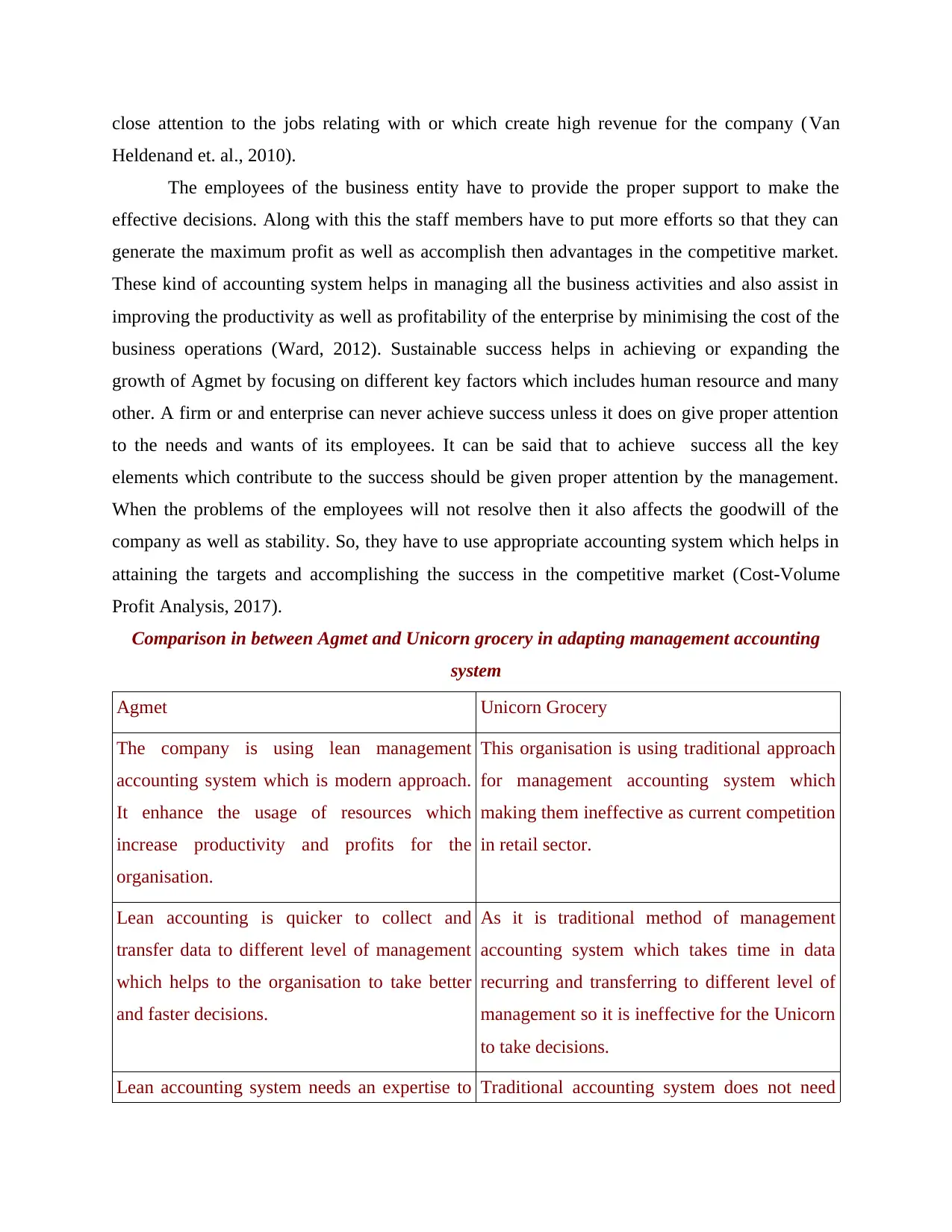
close attention to the jobs relating with or which create high revenue for the company (Van
Heldenand et. al., 2010).
The employees of the business entity have to provide the proper support to make the
effective decisions. Along with this the staff members have to put more efforts so that they can
generate the maximum profit as well as accomplish then advantages in the competitive market.
These kind of accounting system helps in managing all the business activities and also assist in
improving the productivity as well as profitability of the enterprise by minimising the cost of the
business operations (Ward, 2012). Sustainable success helps in achieving or expanding the
growth of Agmet by focusing on different key factors which includes human resource and many
other. A firm or and enterprise can never achieve success unless it does on give proper attention
to the needs and wants of its employees. It can be said that to achieve success all the key
elements which contribute to the success should be given proper attention by the management.
When the problems of the employees will not resolve then it also affects the goodwill of the
company as well as stability. So, they have to use appropriate accounting system which helps in
attaining the targets and accomplishing the success in the competitive market (Cost-Volume
Profit Analysis, 2017).
Comparison in between Agmet and Unicorn grocery in adapting management accounting
system
Agmet Unicorn Grocery
The company is using lean management
accounting system which is modern approach.
It enhance the usage of resources which
increase productivity and profits for the
organisation.
This organisation is using traditional approach
for management accounting system which
making them ineffective as current competition
in retail sector.
Lean accounting is quicker to collect and
transfer data to different level of management
which helps to the organisation to take better
and faster decisions.
As it is traditional method of management
accounting system which takes time in data
recurring and transferring to different level of
management so it is ineffective for the Unicorn
to take decisions.
Lean accounting system needs an expertise to Traditional accounting system does not need
Heldenand et. al., 2010).
The employees of the business entity have to provide the proper support to make the
effective decisions. Along with this the staff members have to put more efforts so that they can
generate the maximum profit as well as accomplish then advantages in the competitive market.
These kind of accounting system helps in managing all the business activities and also assist in
improving the productivity as well as profitability of the enterprise by minimising the cost of the
business operations (Ward, 2012). Sustainable success helps in achieving or expanding the
growth of Agmet by focusing on different key factors which includes human resource and many
other. A firm or and enterprise can never achieve success unless it does on give proper attention
to the needs and wants of its employees. It can be said that to achieve success all the key
elements which contribute to the success should be given proper attention by the management.
When the problems of the employees will not resolve then it also affects the goodwill of the
company as well as stability. So, they have to use appropriate accounting system which helps in
attaining the targets and accomplishing the success in the competitive market (Cost-Volume
Profit Analysis, 2017).
Comparison in between Agmet and Unicorn grocery in adapting management accounting
system
Agmet Unicorn Grocery
The company is using lean management
accounting system which is modern approach.
It enhance the usage of resources which
increase productivity and profits for the
organisation.
This organisation is using traditional approach
for management accounting system which
making them ineffective as current competition
in retail sector.
Lean accounting is quicker to collect and
transfer data to different level of management
which helps to the organisation to take better
and faster decisions.
As it is traditional method of management
accounting system which takes time in data
recurring and transferring to different level of
management so it is ineffective for the Unicorn
to take decisions.
Lean accounting system needs an expertise to Traditional accounting system does not need
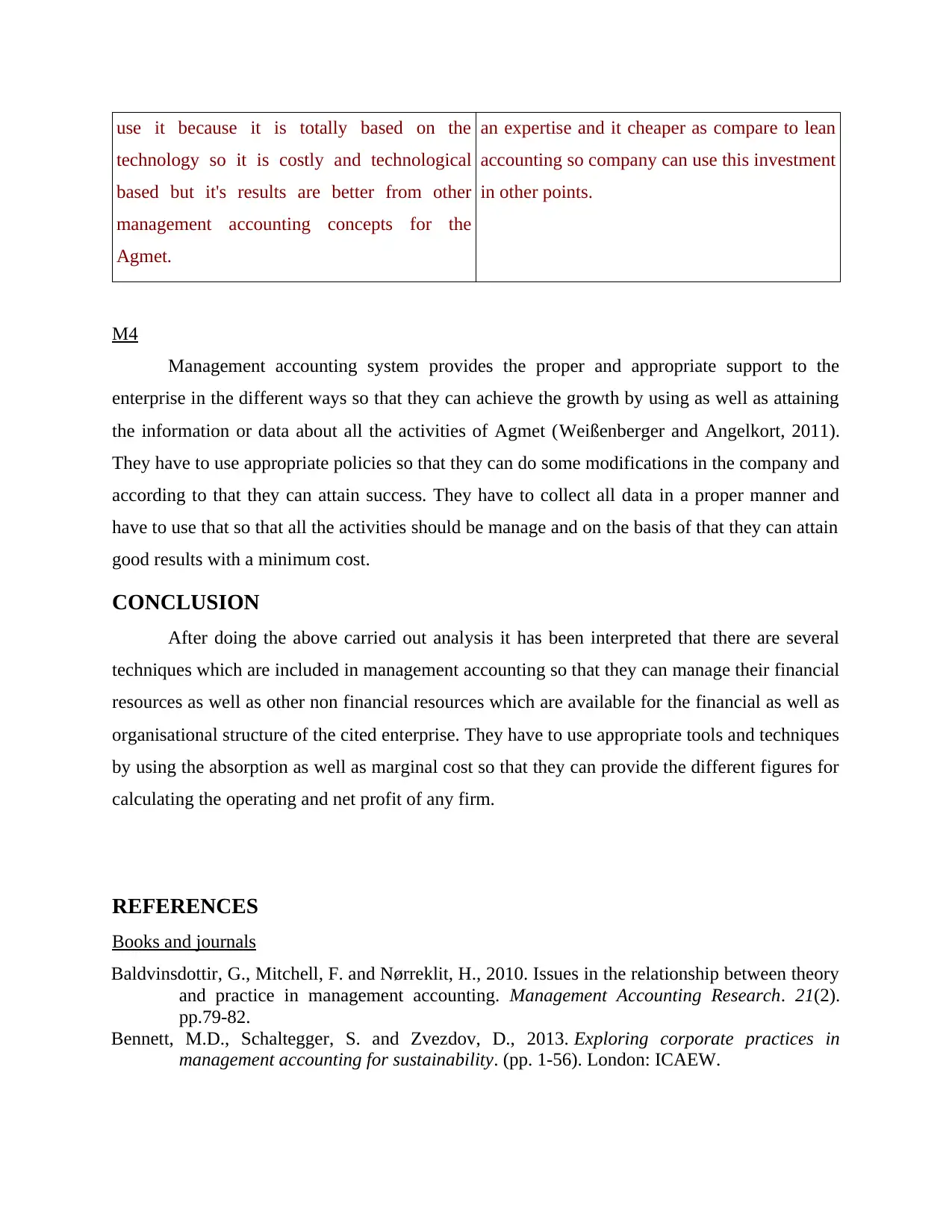
use it because it is totally based on the
technology so it is costly and technological
based but it's results are better from other
management accounting concepts for the
Agmet.
an expertise and it cheaper as compare to lean
accounting so company can use this investment
in other points.
M4
Management accounting system provides the proper and appropriate support to the
enterprise in the different ways so that they can achieve the growth by using as well as attaining
the information or data about all the activities of Agmet (Weißenberger and Angelkort, 2011).
They have to use appropriate policies so that they can do some modifications in the company and
according to that they can attain success. They have to collect all data in a proper manner and
have to use that so that all the activities should be manage and on the basis of that they can attain
good results with a minimum cost.
CONCLUSION
After doing the above carried out analysis it has been interpreted that there are several
techniques which are included in management accounting so that they can manage their financial
resources as well as other non financial resources which are available for the financial as well as
organisational structure of the cited enterprise. They have to use appropriate tools and techniques
by using the absorption as well as marginal cost so that they can provide the different figures for
calculating the operating and net profit of any firm.
REFERENCES
Books and journals
Baldvinsdottir, G., Mitchell, F. and Nørreklit, H., 2010. Issues in the relationship between theory
and practice in management accounting. Management Accounting Research. 21(2).
pp.79-82.
Bennett, M.D., Schaltegger, S. and Zvezdov, D., 2013. Exploring corporate practices in
management accounting for sustainability. (pp. 1-56). London: ICAEW.
technology so it is costly and technological
based but it's results are better from other
management accounting concepts for the
Agmet.
an expertise and it cheaper as compare to lean
accounting so company can use this investment
in other points.
M4
Management accounting system provides the proper and appropriate support to the
enterprise in the different ways so that they can achieve the growth by using as well as attaining
the information or data about all the activities of Agmet (Weißenberger and Angelkort, 2011).
They have to use appropriate policies so that they can do some modifications in the company and
according to that they can attain success. They have to collect all data in a proper manner and
have to use that so that all the activities should be manage and on the basis of that they can attain
good results with a minimum cost.
CONCLUSION
After doing the above carried out analysis it has been interpreted that there are several
techniques which are included in management accounting so that they can manage their financial
resources as well as other non financial resources which are available for the financial as well as
organisational structure of the cited enterprise. They have to use appropriate tools and techniques
by using the absorption as well as marginal cost so that they can provide the different figures for
calculating the operating and net profit of any firm.
REFERENCES
Books and journals
Baldvinsdottir, G., Mitchell, F. and Nørreklit, H., 2010. Issues in the relationship between theory
and practice in management accounting. Management Accounting Research. 21(2).
pp.79-82.
Bennett, M.D., Schaltegger, S. and Zvezdov, D., 2013. Exploring corporate practices in
management accounting for sustainability. (pp. 1-56). London: ICAEW.
You're viewing a preview
Unlock full access by subscribing today!
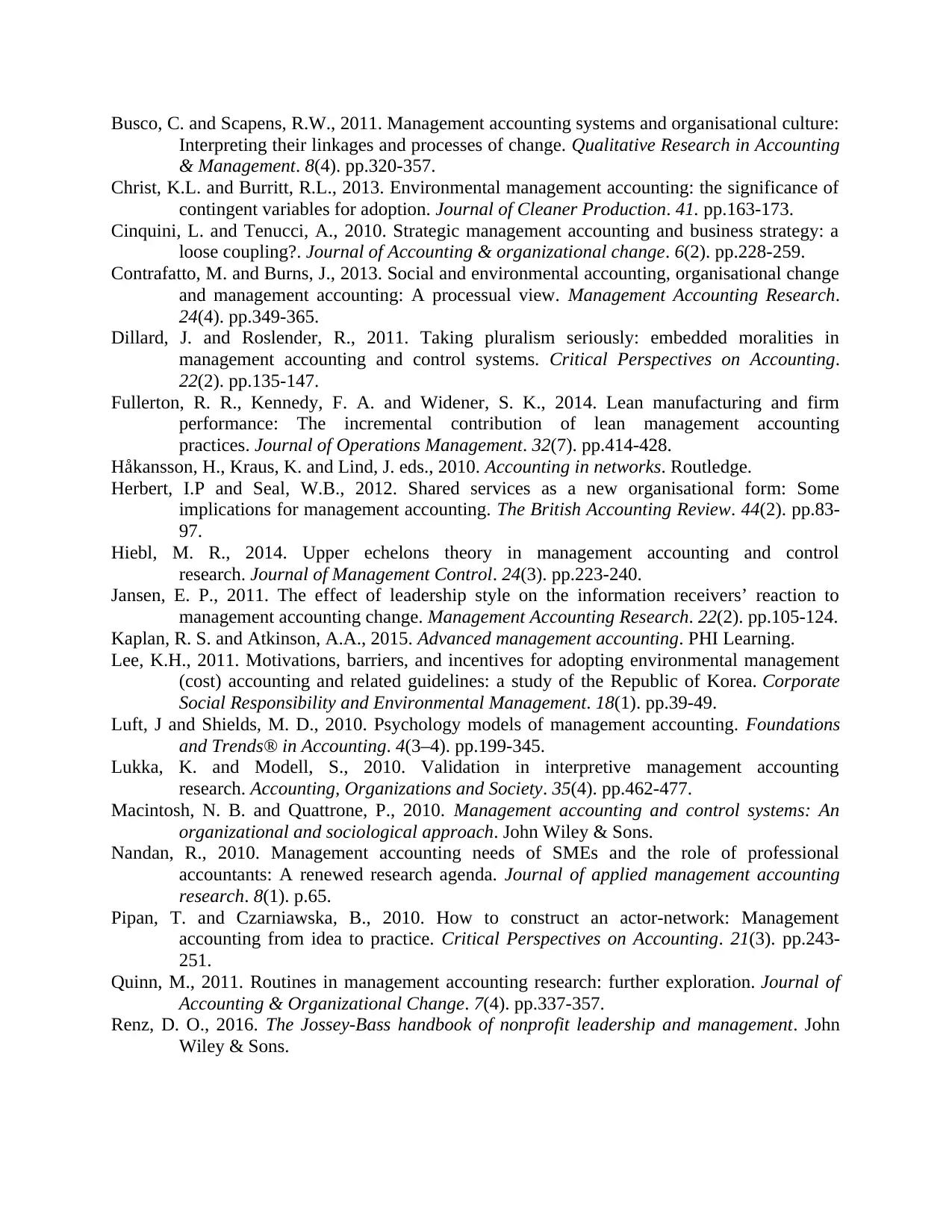
Busco, C. and Scapens, R.W., 2011. Management accounting systems and organisational culture:
Interpreting their linkages and processes of change. Qualitative Research in Accounting
& Management. 8(4). pp.320-357.
Christ, K.L. and Burritt, R.L., 2013. Environmental management accounting: the significance of
contingent variables for adoption. Journal of Cleaner Production. 41. pp.163-173.
Cinquini, L. and Tenucci, A., 2010. Strategic management accounting and business strategy: a
loose coupling?. Journal of Accounting & organizational change. 6(2). pp.228-259.
Contrafatto, M. and Burns, J., 2013. Social and environmental accounting, organisational change
and management accounting: A processual view. Management Accounting Research.
24(4). pp.349-365.
Dillard, J. and Roslender, R., 2011. Taking pluralism seriously: embedded moralities in
management accounting and control systems. Critical Perspectives on Accounting.
22(2). pp.135-147.
Fullerton, R. R., Kennedy, F. A. and Widener, S. K., 2014. Lean manufacturing and firm
performance: The incremental contribution of lean management accounting
practices. Journal of Operations Management. 32(7). pp.414-428.
Håkansson, H., Kraus, K. and Lind, J. eds., 2010. Accounting in networks. Routledge.
Herbert, I.P and Seal, W.B., 2012. Shared services as a new organisational form: Some
implications for management accounting. The British Accounting Review. 44(2). pp.83-
97.
Hiebl, M. R., 2014. Upper echelons theory in management accounting and control
research. Journal of Management Control. 24(3). pp.223-240.
Jansen, E. P., 2011. The effect of leadership style on the information receivers’ reaction to
management accounting change. Management Accounting Research. 22(2). pp.105-124.
Kaplan, R. S. and Atkinson, A.A., 2015. Advanced management accounting. PHI Learning.
Lee, K.H., 2011. Motivations, barriers, and incentives for adopting environmental management
(cost) accounting and related guidelines: a study of the Republic of Korea. Corporate
Social Responsibility and Environmental Management. 18(1). pp.39-49.
Luft, J and Shields, M. D., 2010. Psychology models of management accounting. Foundations
and Trends® in Accounting. 4(3–4). pp.199-345.
Lukka, K. and Modell, S., 2010. Validation in interpretive management accounting
research. Accounting, Organizations and Society. 35(4). pp.462-477.
Macintosh, N. B. and Quattrone, P., 2010. Management accounting and control systems: An
organizational and sociological approach. John Wiley & Sons.
Nandan, R., 2010. Management accounting needs of SMEs and the role of professional
accountants: A renewed research agenda. Journal of applied management accounting
research. 8(1). p.65.
Pipan, T. and Czarniawska, B., 2010. How to construct an actor-network: Management
accounting from idea to practice. Critical Perspectives on Accounting. 21(3). pp.243-
251.
Quinn, M., 2011. Routines in management accounting research: further exploration. Journal of
Accounting & Organizational Change. 7(4). pp.337-357.
Renz, D. O., 2016. The Jossey-Bass handbook of nonprofit leadership and management. John
Wiley & Sons.
Interpreting their linkages and processes of change. Qualitative Research in Accounting
& Management. 8(4). pp.320-357.
Christ, K.L. and Burritt, R.L., 2013. Environmental management accounting: the significance of
contingent variables for adoption. Journal of Cleaner Production. 41. pp.163-173.
Cinquini, L. and Tenucci, A., 2010. Strategic management accounting and business strategy: a
loose coupling?. Journal of Accounting & organizational change. 6(2). pp.228-259.
Contrafatto, M. and Burns, J., 2013. Social and environmental accounting, organisational change
and management accounting: A processual view. Management Accounting Research.
24(4). pp.349-365.
Dillard, J. and Roslender, R., 2011. Taking pluralism seriously: embedded moralities in
management accounting and control systems. Critical Perspectives on Accounting.
22(2). pp.135-147.
Fullerton, R. R., Kennedy, F. A. and Widener, S. K., 2014. Lean manufacturing and firm
performance: The incremental contribution of lean management accounting
practices. Journal of Operations Management. 32(7). pp.414-428.
Håkansson, H., Kraus, K. and Lind, J. eds., 2010. Accounting in networks. Routledge.
Herbert, I.P and Seal, W.B., 2012. Shared services as a new organisational form: Some
implications for management accounting. The British Accounting Review. 44(2). pp.83-
97.
Hiebl, M. R., 2014. Upper echelons theory in management accounting and control
research. Journal of Management Control. 24(3). pp.223-240.
Jansen, E. P., 2011. The effect of leadership style on the information receivers’ reaction to
management accounting change. Management Accounting Research. 22(2). pp.105-124.
Kaplan, R. S. and Atkinson, A.A., 2015. Advanced management accounting. PHI Learning.
Lee, K.H., 2011. Motivations, barriers, and incentives for adopting environmental management
(cost) accounting and related guidelines: a study of the Republic of Korea. Corporate
Social Responsibility and Environmental Management. 18(1). pp.39-49.
Luft, J and Shields, M. D., 2010. Psychology models of management accounting. Foundations
and Trends® in Accounting. 4(3–4). pp.199-345.
Lukka, K. and Modell, S., 2010. Validation in interpretive management accounting
research. Accounting, Organizations and Society. 35(4). pp.462-477.
Macintosh, N. B. and Quattrone, P., 2010. Management accounting and control systems: An
organizational and sociological approach. John Wiley & Sons.
Nandan, R., 2010. Management accounting needs of SMEs and the role of professional
accountants: A renewed research agenda. Journal of applied management accounting
research. 8(1). p.65.
Pipan, T. and Czarniawska, B., 2010. How to construct an actor-network: Management
accounting from idea to practice. Critical Perspectives on Accounting. 21(3). pp.243-
251.
Quinn, M., 2011. Routines in management accounting research: further exploration. Journal of
Accounting & Organizational Change. 7(4). pp.337-357.
Renz, D. O., 2016. The Jossey-Bass handbook of nonprofit leadership and management. John
Wiley & Sons.
Paraphrase This Document
Need a fresh take? Get an instant paraphrase of this document with our AI Paraphraser
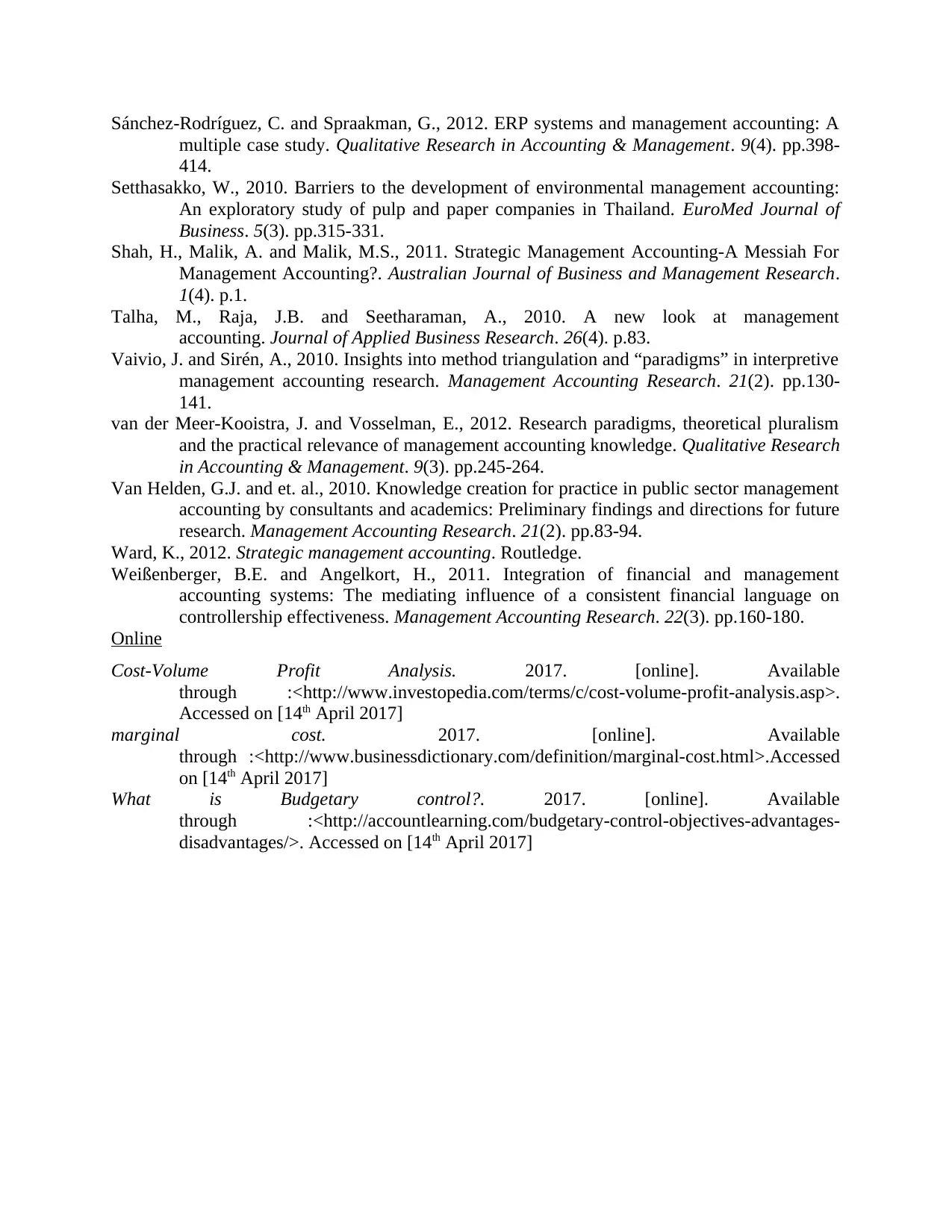
Sánchez-Rodríguez, C. and Spraakman, G., 2012. ERP systems and management accounting: A
multiple case study. Qualitative Research in Accounting & Management. 9(4). pp.398-
414.
Setthasakko, W., 2010. Barriers to the development of environmental management accounting:
An exploratory study of pulp and paper companies in Thailand. EuroMed Journal of
Business. 5(3). pp.315-331.
Shah, H., Malik, A. and Malik, M.S., 2011. Strategic Management Accounting-A Messiah For
Management Accounting?. Australian Journal of Business and Management Research.
1(4). p.1.
Talha, M., Raja, J.B. and Seetharaman, A., 2010. A new look at management
accounting. Journal of Applied Business Research. 26(4). p.83.
Vaivio, J. and Sirén, A., 2010. Insights into method triangulation and “paradigms” in interpretive
management accounting research. Management Accounting Research. 21(2). pp.130-
141.
van der Meer-Kooistra, J. and Vosselman, E., 2012. Research paradigms, theoretical pluralism
and the practical relevance of management accounting knowledge. Qualitative Research
in Accounting & Management. 9(3). pp.245-264.
Van Helden, G.J. and et. al., 2010. Knowledge creation for practice in public sector management
accounting by consultants and academics: Preliminary findings and directions for future
research. Management Accounting Research. 21(2). pp.83-94.
Ward, K., 2012. Strategic management accounting. Routledge.
Weißenberger, B.E. and Angelkort, H., 2011. Integration of financial and management
accounting systems: The mediating influence of a consistent financial language on
controllership effectiveness. Management Accounting Research. 22(3). pp.160-180.
Online
Cost-Volume Profit Analysis. 2017. [online]. Available
through :<http://www.investopedia.com/terms/c/cost-volume-profit-analysis.asp>.
Accessed on [14th April 2017]
marginal cost. 2017. [online]. Available
through :<http://www.businessdictionary.com/definition/marginal-cost.html>.Accessed
on [14th April 2017]
What is Budgetary control?. 2017. [online]. Available
through :<http://accountlearning.com/budgetary-control-objectives-advantages-
disadvantages/>. Accessed on [14th April 2017]
multiple case study. Qualitative Research in Accounting & Management. 9(4). pp.398-
414.
Setthasakko, W., 2010. Barriers to the development of environmental management accounting:
An exploratory study of pulp and paper companies in Thailand. EuroMed Journal of
Business. 5(3). pp.315-331.
Shah, H., Malik, A. and Malik, M.S., 2011. Strategic Management Accounting-A Messiah For
Management Accounting?. Australian Journal of Business and Management Research.
1(4). p.1.
Talha, M., Raja, J.B. and Seetharaman, A., 2010. A new look at management
accounting. Journal of Applied Business Research. 26(4). p.83.
Vaivio, J. and Sirén, A., 2010. Insights into method triangulation and “paradigms” in interpretive
management accounting research. Management Accounting Research. 21(2). pp.130-
141.
van der Meer-Kooistra, J. and Vosselman, E., 2012. Research paradigms, theoretical pluralism
and the practical relevance of management accounting knowledge. Qualitative Research
in Accounting & Management. 9(3). pp.245-264.
Van Helden, G.J. and et. al., 2010. Knowledge creation for practice in public sector management
accounting by consultants and academics: Preliminary findings and directions for future
research. Management Accounting Research. 21(2). pp.83-94.
Ward, K., 2012. Strategic management accounting. Routledge.
Weißenberger, B.E. and Angelkort, H., 2011. Integration of financial and management
accounting systems: The mediating influence of a consistent financial language on
controllership effectiveness. Management Accounting Research. 22(3). pp.160-180.
Online
Cost-Volume Profit Analysis. 2017. [online]. Available
through :<http://www.investopedia.com/terms/c/cost-volume-profit-analysis.asp>.
Accessed on [14th April 2017]
marginal cost. 2017. [online]. Available
through :<http://www.businessdictionary.com/definition/marginal-cost.html>.Accessed
on [14th April 2017]
What is Budgetary control?. 2017. [online]. Available
through :<http://accountlearning.com/budgetary-control-objectives-advantages-
disadvantages/>. Accessed on [14th April 2017]
1 out of 17
Related Documents
Your All-in-One AI-Powered Toolkit for Academic Success.
+13062052269
info@desklib.com
Available 24*7 on WhatsApp / Email
![[object Object]](/_next/static/media/star-bottom.7253800d.svg)
Unlock your academic potential
© 2024 | Zucol Services PVT LTD | All rights reserved.





